Community Development on Malnutrition in Africa
VerifiedAdded on 2023/06/15
|33
|6995
|284
AI Summary
This report discusses the issue of malnutrition in Africa, which presents significant threats to human health. It critically evaluates research articles that elaborate on interventions to reduce under-nutrition in Africa. The report highlights the importance of community development strategies to address malnutrition and enhance the overall growth and wellbeing of individuals.
Contribute Materials
Your contribution can guide someone’s learning journey. Share your
documents today.
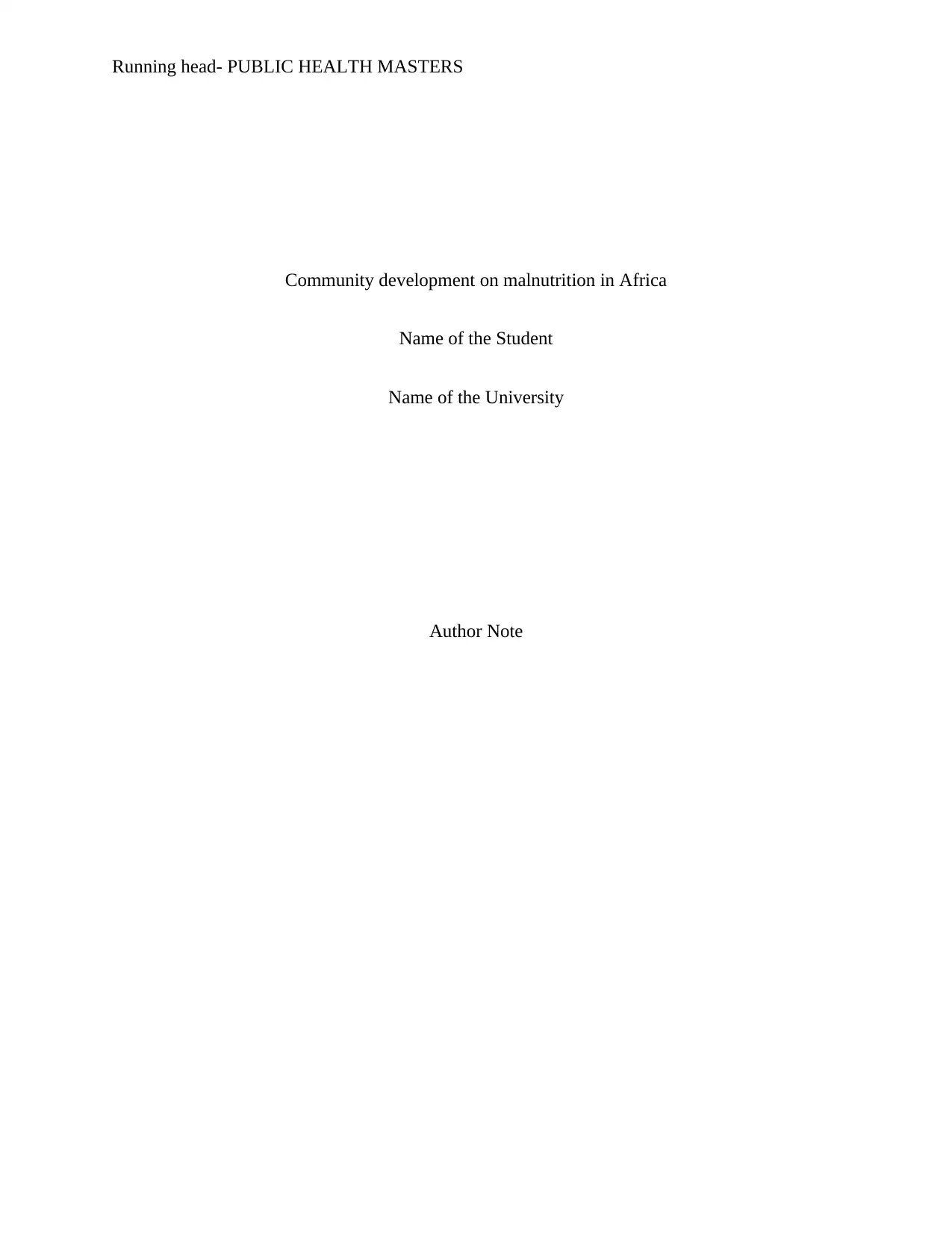
Running head- PUBLIC HEALTH MASTERS
Community development on malnutrition in Africa
Name of the Student
Name of the University
Author Note
Community development on malnutrition in Africa
Name of the Student
Name of the University
Author Note
Secure Best Marks with AI Grader
Need help grading? Try our AI Grader for instant feedback on your assignments.
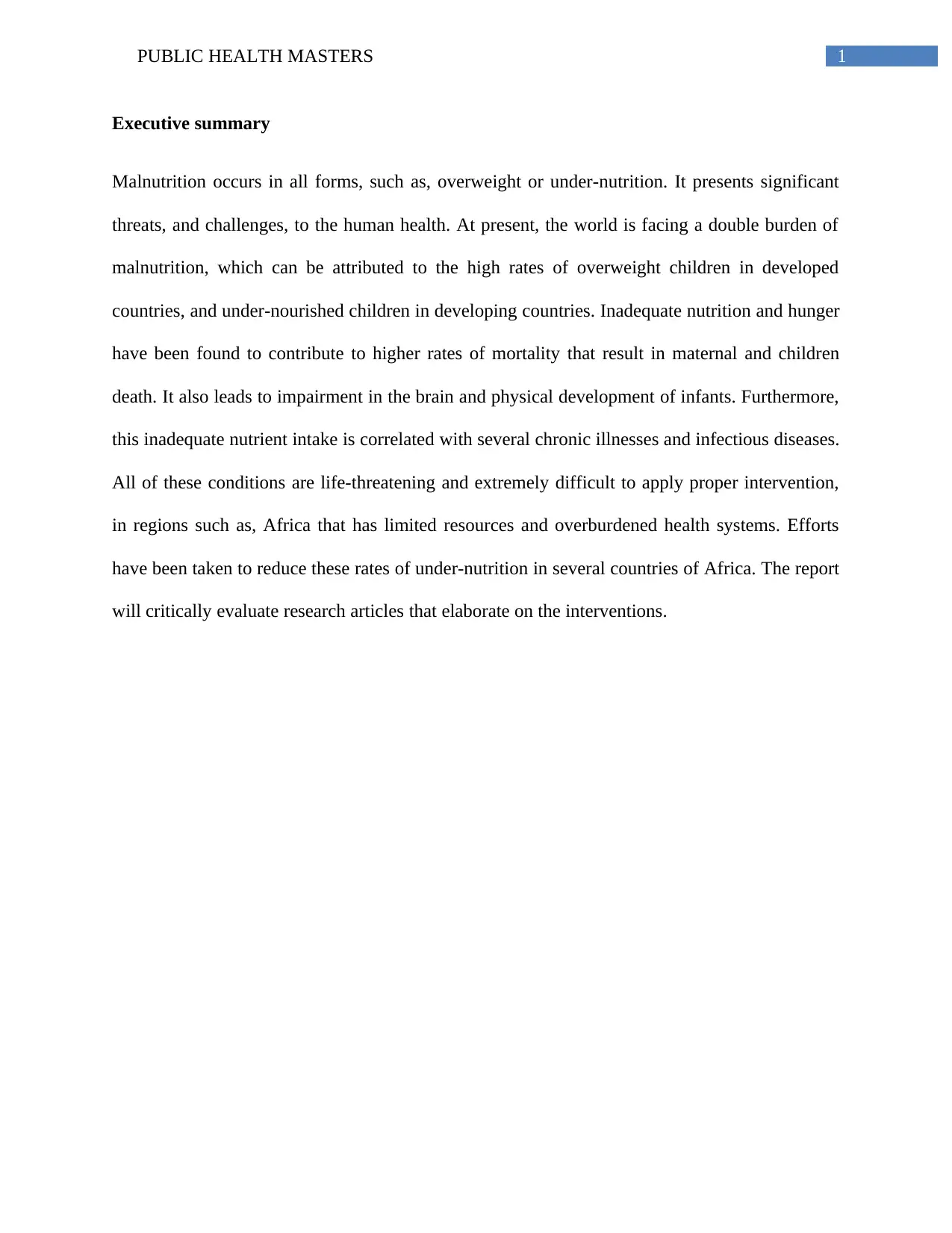
1PUBLIC HEALTH MASTERS
Executive summary
Malnutrition occurs in all forms, such as, overweight or under-nutrition. It presents significant
threats, and challenges, to the human health. At present, the world is facing a double burden of
malnutrition, which can be attributed to the high rates of overweight children in developed
countries, and under-nourished children in developing countries. Inadequate nutrition and hunger
have been found to contribute to higher rates of mortality that result in maternal and children
death. It also leads to impairment in the brain and physical development of infants. Furthermore,
this inadequate nutrient intake is correlated with several chronic illnesses and infectious diseases.
All of these conditions are life-threatening and extremely difficult to apply proper intervention,
in regions such as, Africa that has limited resources and overburdened health systems. Efforts
have been taken to reduce these rates of under-nutrition in several countries of Africa. The report
will critically evaluate research articles that elaborate on the interventions.
Executive summary
Malnutrition occurs in all forms, such as, overweight or under-nutrition. It presents significant
threats, and challenges, to the human health. At present, the world is facing a double burden of
malnutrition, which can be attributed to the high rates of overweight children in developed
countries, and under-nourished children in developing countries. Inadequate nutrition and hunger
have been found to contribute to higher rates of mortality that result in maternal and children
death. It also leads to impairment in the brain and physical development of infants. Furthermore,
this inadequate nutrient intake is correlated with several chronic illnesses and infectious diseases.
All of these conditions are life-threatening and extremely difficult to apply proper intervention,
in regions such as, Africa that has limited resources and overburdened health systems. Efforts
have been taken to reduce these rates of under-nutrition in several countries of Africa. The report
will critically evaluate research articles that elaborate on the interventions.
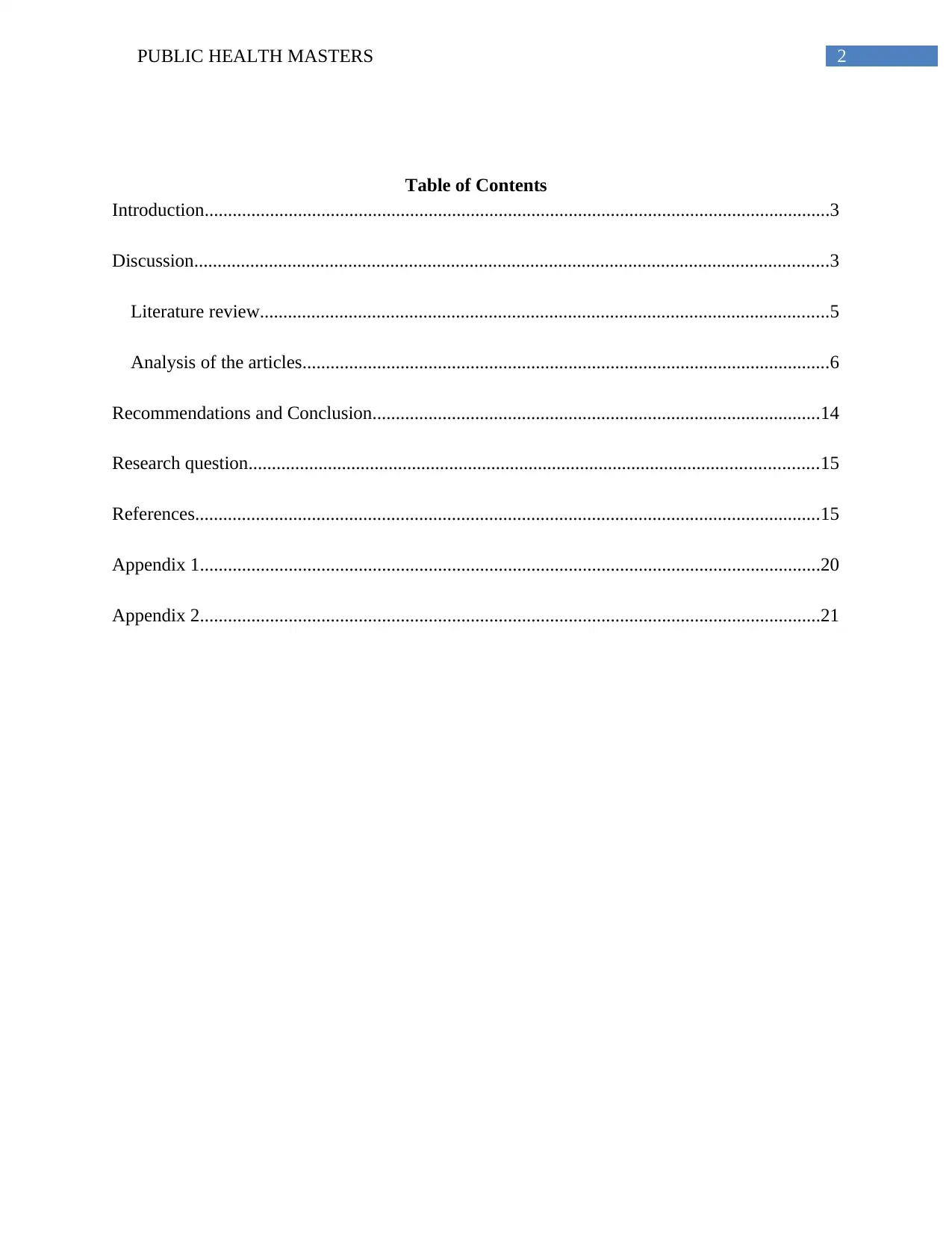
2PUBLIC HEALTH MASTERS
Table of Contents
Introduction......................................................................................................................................3
Discussion........................................................................................................................................3
Literature review..........................................................................................................................5
Analysis of the articles.................................................................................................................6
Recommendations and Conclusion................................................................................................14
Research question..........................................................................................................................15
References......................................................................................................................................15
Appendix 1.....................................................................................................................................20
Appendix 2.....................................................................................................................................21
Table of Contents
Introduction......................................................................................................................................3
Discussion........................................................................................................................................3
Literature review..........................................................................................................................5
Analysis of the articles.................................................................................................................6
Recommendations and Conclusion................................................................................................14
Research question..........................................................................................................................15
References......................................................................................................................................15
Appendix 1.....................................................................................................................................20
Appendix 2.....................................................................................................................................21
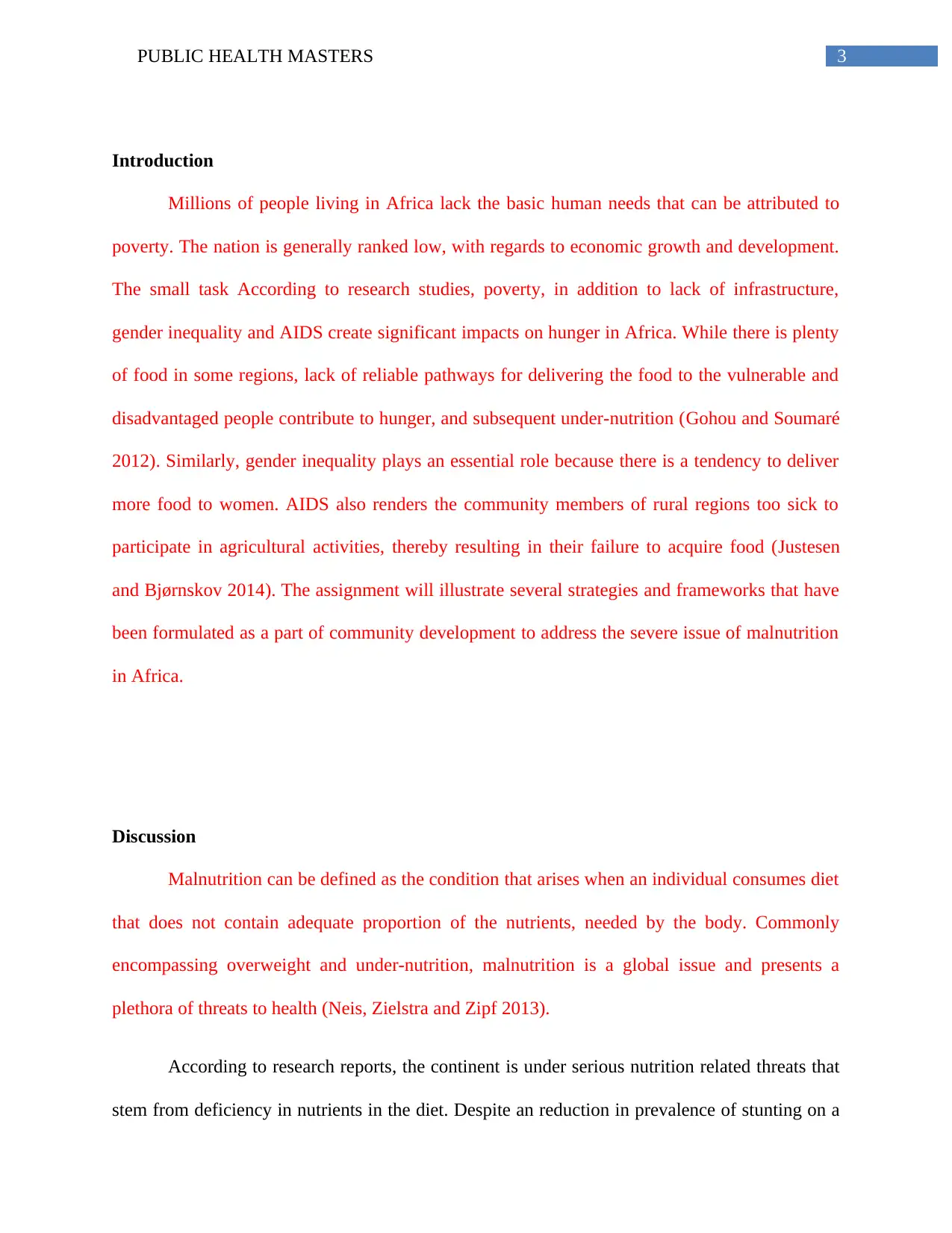
3PUBLIC HEALTH MASTERS
Introduction
Millions of people living in Africa lack the basic human needs that can be attributed to
poverty. The nation is generally ranked low, with regards to economic growth and development.
The small task According to research studies, poverty, in addition to lack of infrastructure,
gender inequality and AIDS create significant impacts on hunger in Africa. While there is plenty
of food in some regions, lack of reliable pathways for delivering the food to the vulnerable and
disadvantaged people contribute to hunger, and subsequent under-nutrition (Gohou and Soumaré
2012). Similarly, gender inequality plays an essential role because there is a tendency to deliver
more food to women. AIDS also renders the community members of rural regions too sick to
participate in agricultural activities, thereby resulting in their failure to acquire food (Justesen
and Bjørnskov 2014). The assignment will illustrate several strategies and frameworks that have
been formulated as a part of community development to address the severe issue of malnutrition
in Africa.
Discussion
Malnutrition can be defined as the condition that arises when an individual consumes diet
that does not contain adequate proportion of the nutrients, needed by the body. Commonly
encompassing overweight and under-nutrition, malnutrition is a global issue and presents a
plethora of threats to health (Neis, Zielstra and Zipf 2013).
According to research reports, the continent is under serious nutrition related threats that
stem from deficiency in nutrients in the diet. Despite an reduction in prevalence of stunting on a
Introduction
Millions of people living in Africa lack the basic human needs that can be attributed to
poverty. The nation is generally ranked low, with regards to economic growth and development.
The small task According to research studies, poverty, in addition to lack of infrastructure,
gender inequality and AIDS create significant impacts on hunger in Africa. While there is plenty
of food in some regions, lack of reliable pathways for delivering the food to the vulnerable and
disadvantaged people contribute to hunger, and subsequent under-nutrition (Gohou and Soumaré
2012). Similarly, gender inequality plays an essential role because there is a tendency to deliver
more food to women. AIDS also renders the community members of rural regions too sick to
participate in agricultural activities, thereby resulting in their failure to acquire food (Justesen
and Bjørnskov 2014). The assignment will illustrate several strategies and frameworks that have
been formulated as a part of community development to address the severe issue of malnutrition
in Africa.
Discussion
Malnutrition can be defined as the condition that arises when an individual consumes diet
that does not contain adequate proportion of the nutrients, needed by the body. Commonly
encompassing overweight and under-nutrition, malnutrition is a global issue and presents a
plethora of threats to health (Neis, Zielstra and Zipf 2013).
According to research reports, the continent is under serious nutrition related threats that
stem from deficiency in nutrients in the diet. Despite an reduction in prevalence of stunting on a
Secure Best Marks with AI Grader
Need help grading? Try our AI Grader for instant feedback on your assignments.
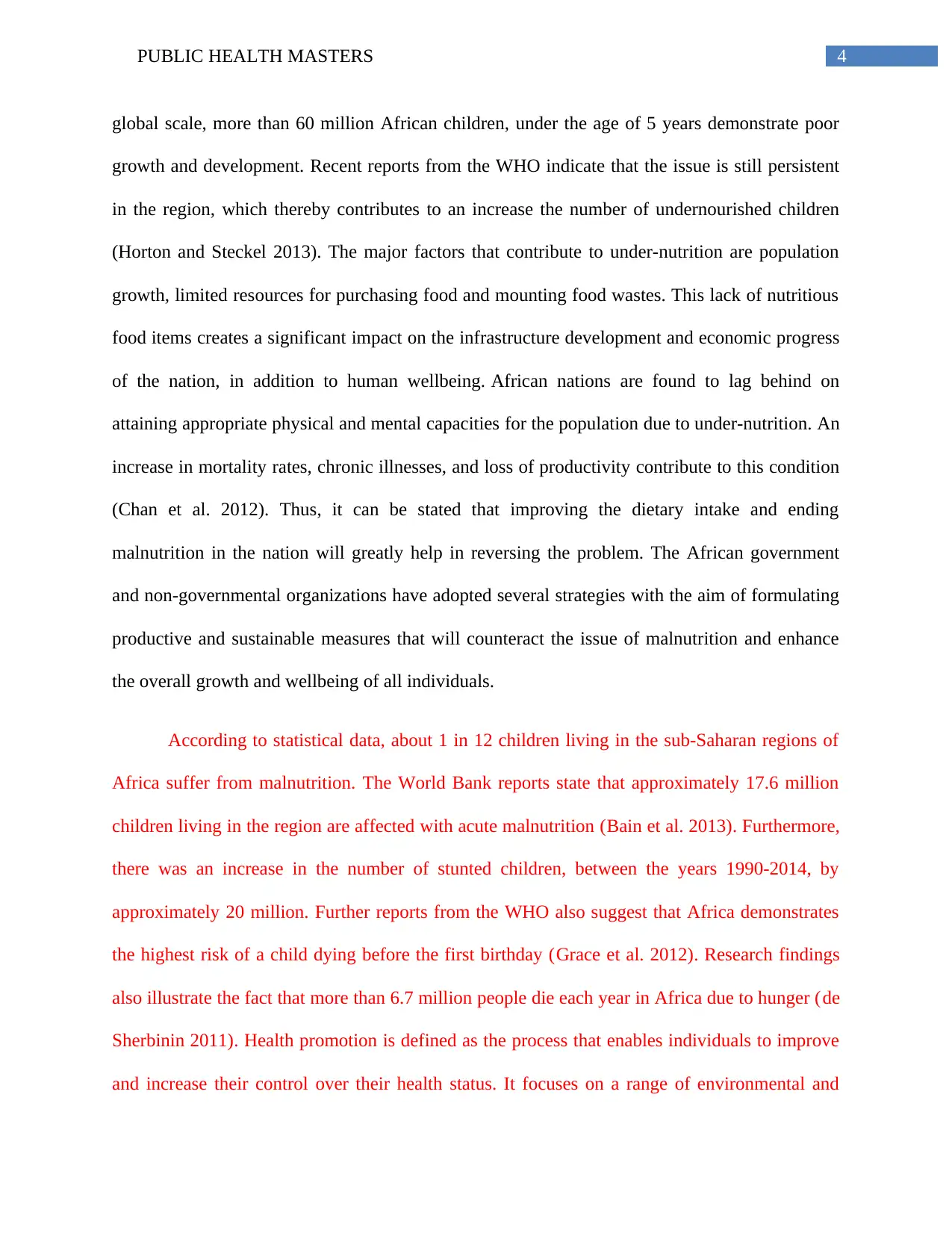
4PUBLIC HEALTH MASTERS
global scale, more than 60 million African children, under the age of 5 years demonstrate poor
growth and development. Recent reports from the WHO indicate that the issue is still persistent
in the region, which thereby contributes to an increase the number of undernourished children
(Horton and Steckel 2013). The major factors that contribute to under-nutrition are population
growth, limited resources for purchasing food and mounting food wastes. This lack of nutritious
food items creates a significant impact on the infrastructure development and economic progress
of the nation, in addition to human wellbeing. African nations are found to lag behind on
attaining appropriate physical and mental capacities for the population due to under-nutrition. An
increase in mortality rates, chronic illnesses, and loss of productivity contribute to this condition
(Chan et al. 2012). Thus, it can be stated that improving the dietary intake and ending
malnutrition in the nation will greatly help in reversing the problem. The African government
and non-governmental organizations have adopted several strategies with the aim of formulating
productive and sustainable measures that will counteract the issue of malnutrition and enhance
the overall growth and wellbeing of all individuals.
According to statistical data, about 1 in 12 children living in the sub-Saharan regions of
Africa suffer from malnutrition. The World Bank reports state that approximately 17.6 million
children living in the region are affected with acute malnutrition (Bain et al. 2013). Furthermore,
there was an increase in the number of stunted children, between the years 1990-2014, by
approximately 20 million. Further reports from the WHO also suggest that Africa demonstrates
the highest risk of a child dying before the first birthday (Grace et al. 2012). Research findings
also illustrate the fact that more than 6.7 million people die each year in Africa due to hunger (de
Sherbinin 2011). Health promotion is defined as the process that enables individuals to improve
and increase their control over their health status. It focuses on a range of environmental and
global scale, more than 60 million African children, under the age of 5 years demonstrate poor
growth and development. Recent reports from the WHO indicate that the issue is still persistent
in the region, which thereby contributes to an increase the number of undernourished children
(Horton and Steckel 2013). The major factors that contribute to under-nutrition are population
growth, limited resources for purchasing food and mounting food wastes. This lack of nutritious
food items creates a significant impact on the infrastructure development and economic progress
of the nation, in addition to human wellbeing. African nations are found to lag behind on
attaining appropriate physical and mental capacities for the population due to under-nutrition. An
increase in mortality rates, chronic illnesses, and loss of productivity contribute to this condition
(Chan et al. 2012). Thus, it can be stated that improving the dietary intake and ending
malnutrition in the nation will greatly help in reversing the problem. The African government
and non-governmental organizations have adopted several strategies with the aim of formulating
productive and sustainable measures that will counteract the issue of malnutrition and enhance
the overall growth and wellbeing of all individuals.
According to statistical data, about 1 in 12 children living in the sub-Saharan regions of
Africa suffer from malnutrition. The World Bank reports state that approximately 17.6 million
children living in the region are affected with acute malnutrition (Bain et al. 2013). Furthermore,
there was an increase in the number of stunted children, between the years 1990-2014, by
approximately 20 million. Further reports from the WHO also suggest that Africa demonstrates
the highest risk of a child dying before the first birthday (Grace et al. 2012). Research findings
also illustrate the fact that more than 6.7 million people die each year in Africa due to hunger (de
Sherbinin 2011). Health promotion is defined as the process that enables individuals to improve
and increase their control over their health status. It focuses on a range of environmental and
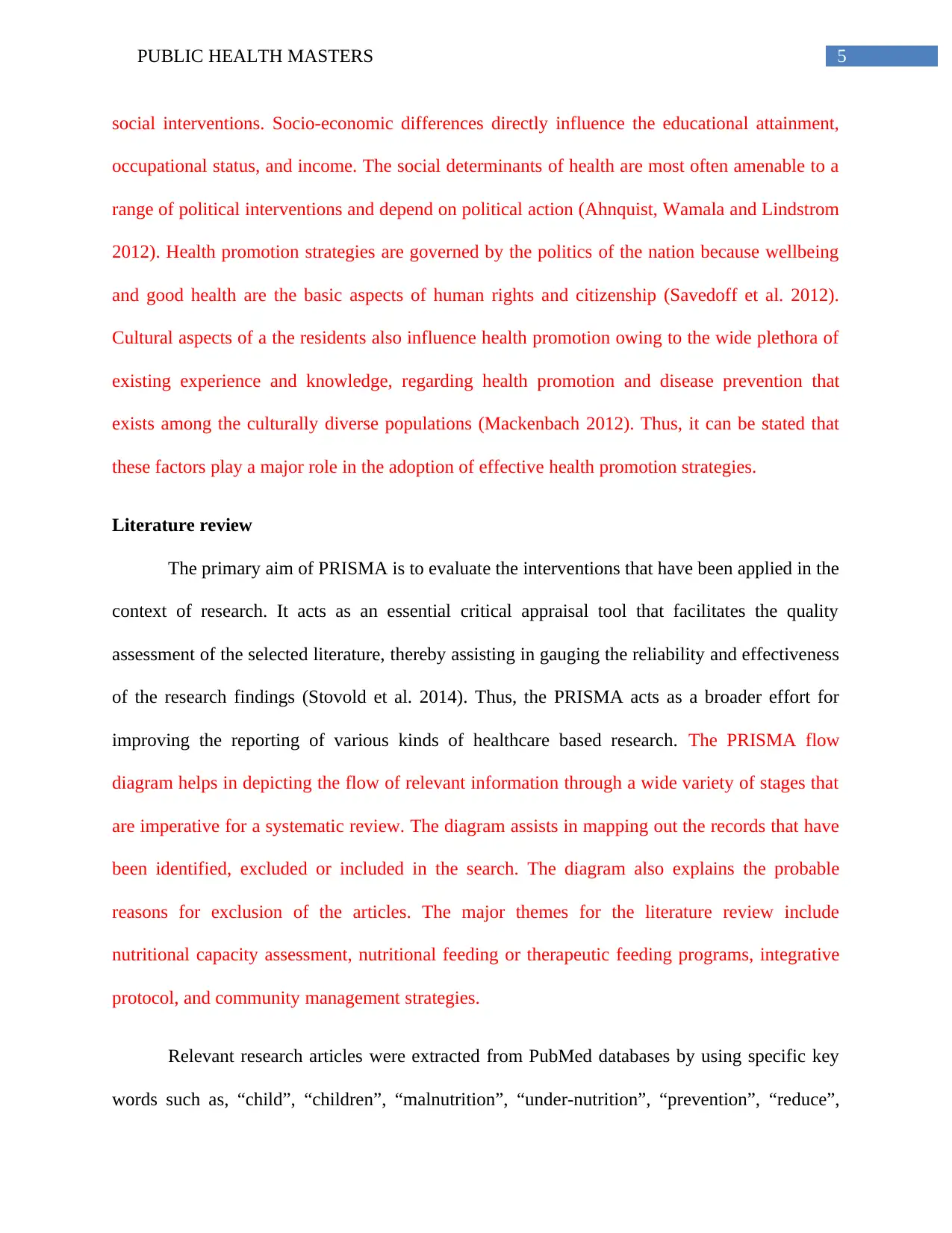
5PUBLIC HEALTH MASTERS
social interventions. Socio-economic differences directly influence the educational attainment,
occupational status, and income. The social determinants of health are most often amenable to a
range of political interventions and depend on political action (Ahnquist, Wamala and Lindstrom
2012). Health promotion strategies are governed by the politics of the nation because wellbeing
and good health are the basic aspects of human rights and citizenship (Savedoff et al. 2012).
Cultural aspects of a the residents also influence health promotion owing to the wide plethora of
existing experience and knowledge, regarding health promotion and disease prevention that
exists among the culturally diverse populations (Mackenbach 2012). Thus, it can be stated that
these factors play a major role in the adoption of effective health promotion strategies.
Literature review
The primary aim of PRISMA is to evaluate the interventions that have been applied in the
context of research. It acts as an essential critical appraisal tool that facilitates the quality
assessment of the selected literature, thereby assisting in gauging the reliability and effectiveness
of the research findings (Stovold et al. 2014). Thus, the PRISMA acts as a broader effort for
improving the reporting of various kinds of healthcare based research. The PRISMA flow
diagram helps in depicting the flow of relevant information through a wide variety of stages that
are imperative for a systematic review. The diagram assists in mapping out the records that have
been identified, excluded or included in the search. The diagram also explains the probable
reasons for exclusion of the articles. The major themes for the literature review include
nutritional capacity assessment, nutritional feeding or therapeutic feeding programs, integrative
protocol, and community management strategies.
Relevant research articles were extracted from PubMed databases by using specific key
words such as, “child”, “children”, “malnutrition”, “under-nutrition”, “prevention”, “reduce”,
social interventions. Socio-economic differences directly influence the educational attainment,
occupational status, and income. The social determinants of health are most often amenable to a
range of political interventions and depend on political action (Ahnquist, Wamala and Lindstrom
2012). Health promotion strategies are governed by the politics of the nation because wellbeing
and good health are the basic aspects of human rights and citizenship (Savedoff et al. 2012).
Cultural aspects of a the residents also influence health promotion owing to the wide plethora of
existing experience and knowledge, regarding health promotion and disease prevention that
exists among the culturally diverse populations (Mackenbach 2012). Thus, it can be stated that
these factors play a major role in the adoption of effective health promotion strategies.
Literature review
The primary aim of PRISMA is to evaluate the interventions that have been applied in the
context of research. It acts as an essential critical appraisal tool that facilitates the quality
assessment of the selected literature, thereby assisting in gauging the reliability and effectiveness
of the research findings (Stovold et al. 2014). Thus, the PRISMA acts as a broader effort for
improving the reporting of various kinds of healthcare based research. The PRISMA flow
diagram helps in depicting the flow of relevant information through a wide variety of stages that
are imperative for a systematic review. The diagram assists in mapping out the records that have
been identified, excluded or included in the search. The diagram also explains the probable
reasons for exclusion of the articles. The major themes for the literature review include
nutritional capacity assessment, nutritional feeding or therapeutic feeding programs, integrative
protocol, and community management strategies.
Relevant research articles were extracted from PubMed databases by using specific key
words such as, “child”, “children”, “malnutrition”, “under-nutrition”, “prevention”, “reduce”,
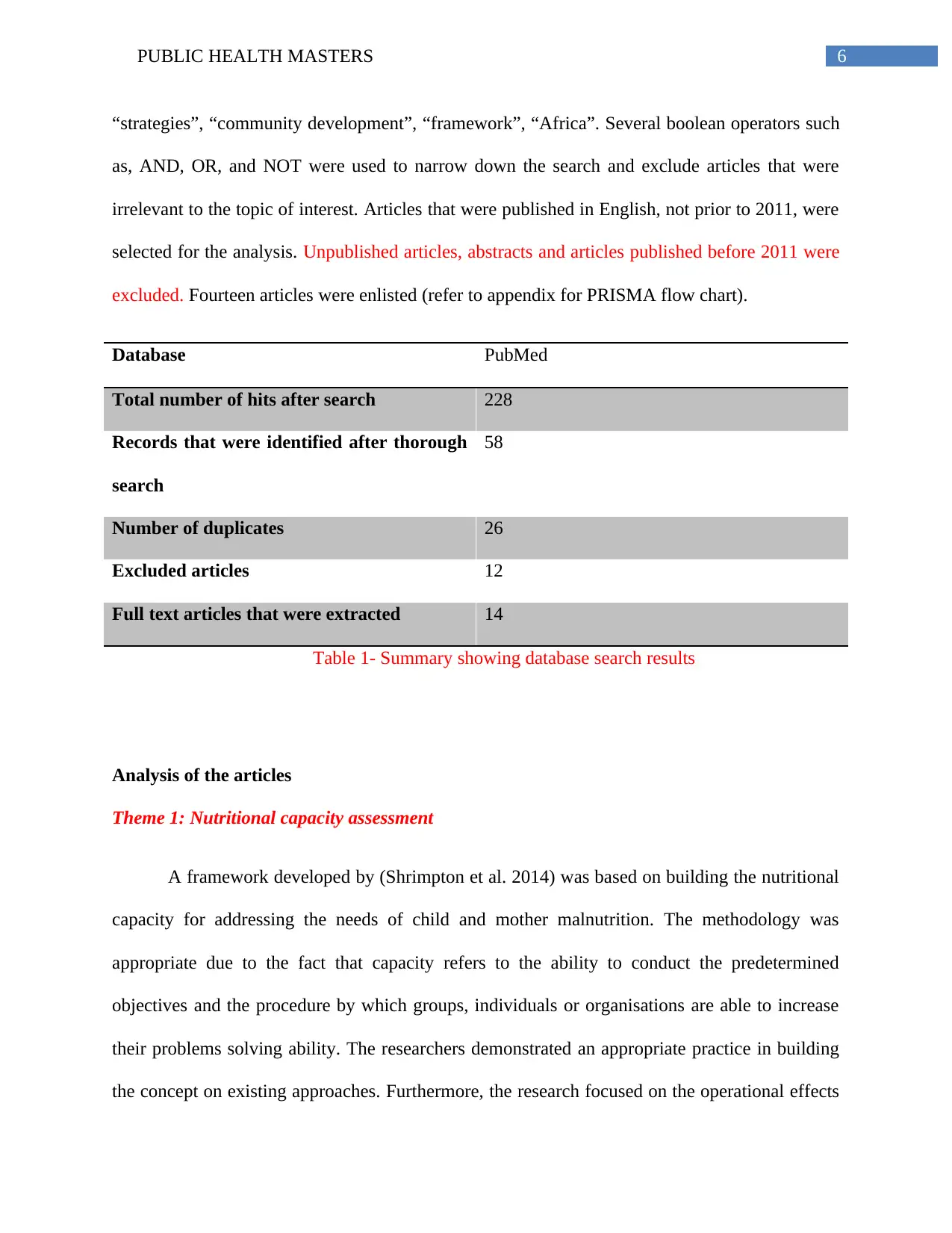
6PUBLIC HEALTH MASTERS
“strategies”, “community development”, “framework”, “Africa”. Several boolean operators such
as, AND, OR, and NOT were used to narrow down the search and exclude articles that were
irrelevant to the topic of interest. Articles that were published in English, not prior to 2011, were
selected for the analysis. Unpublished articles, abstracts and articles published before 2011 were
excluded. Fourteen articles were enlisted (refer to appendix for PRISMA flow chart).
Database PubMed
Total number of hits after search 228
Records that were identified after thorough
search
58
Number of duplicates 26
Excluded articles 12
Full text articles that were extracted 14
Table 1- Summary showing database search results
Analysis of the articles
Theme 1: Nutritional capacity assessment
A framework developed by (Shrimpton et al. 2014) was based on building the nutritional
capacity for addressing the needs of child and mother malnutrition. The methodology was
appropriate due to the fact that capacity refers to the ability to conduct the predetermined
objectives and the procedure by which groups, individuals or organisations are able to increase
their problems solving ability. The researchers demonstrated an appropriate practice in building
the concept on existing approaches. Furthermore, the research focused on the operational effects
“strategies”, “community development”, “framework”, “Africa”. Several boolean operators such
as, AND, OR, and NOT were used to narrow down the search and exclude articles that were
irrelevant to the topic of interest. Articles that were published in English, not prior to 2011, were
selected for the analysis. Unpublished articles, abstracts and articles published before 2011 were
excluded. Fourteen articles were enlisted (refer to appendix for PRISMA flow chart).
Database PubMed
Total number of hits after search 228
Records that were identified after thorough
search
58
Number of duplicates 26
Excluded articles 12
Full text articles that were extracted 14
Table 1- Summary showing database search results
Analysis of the articles
Theme 1: Nutritional capacity assessment
A framework developed by (Shrimpton et al. 2014) was based on building the nutritional
capacity for addressing the needs of child and mother malnutrition. The methodology was
appropriate due to the fact that capacity refers to the ability to conduct the predetermined
objectives and the procedure by which groups, individuals or organisations are able to increase
their problems solving ability. The researchers demonstrated an appropriate practice in building
the concept on existing approaches. Furthermore, the research focused on the operational effects
Paraphrase This Document
Need a fresh take? Get an instant paraphrase of this document with our AI Paraphraser
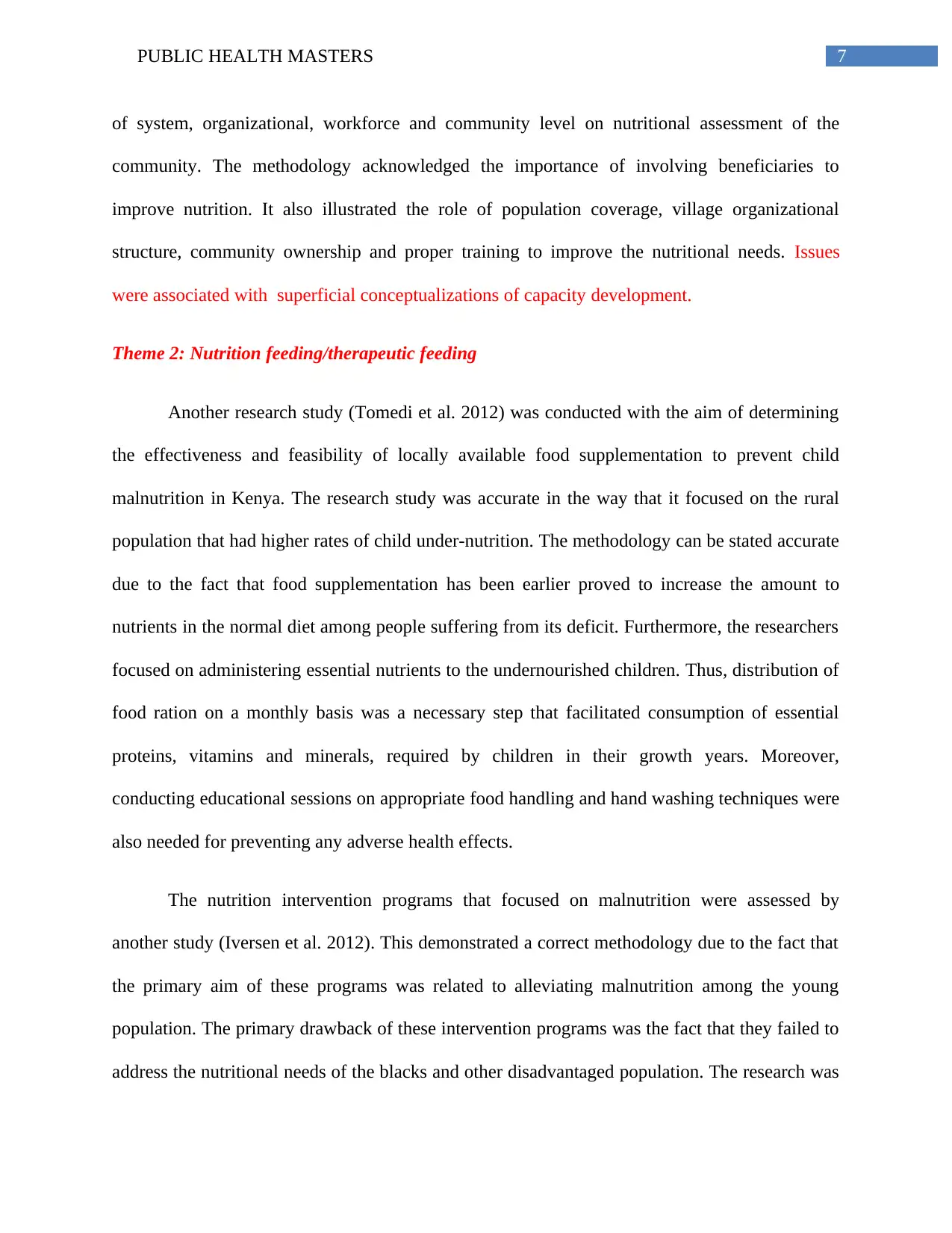
7PUBLIC HEALTH MASTERS
of system, organizational, workforce and community level on nutritional assessment of the
community. The methodology acknowledged the importance of involving beneficiaries to
improve nutrition. It also illustrated the role of population coverage, village organizational
structure, community ownership and proper training to improve the nutritional needs. Issues
were associated with superficial conceptualizations of capacity development.
Theme 2: Nutrition feeding/therapeutic feeding
Another research study (Tomedi et al. 2012) was conducted with the aim of determining
the effectiveness and feasibility of locally available food supplementation to prevent child
malnutrition in Kenya. The research study was accurate in the way that it focused on the rural
population that had higher rates of child under-nutrition. The methodology can be stated accurate
due to the fact that food supplementation has been earlier proved to increase the amount to
nutrients in the normal diet among people suffering from its deficit. Furthermore, the researchers
focused on administering essential nutrients to the undernourished children. Thus, distribution of
food ration on a monthly basis was a necessary step that facilitated consumption of essential
proteins, vitamins and minerals, required by children in their growth years. Moreover,
conducting educational sessions on appropriate food handling and hand washing techniques were
also needed for preventing any adverse health effects.
The nutrition intervention programs that focused on malnutrition were assessed by
another study (Iversen et al. 2012). This demonstrated a correct methodology due to the fact that
the primary aim of these programs was related to alleviating malnutrition among the young
population. The primary drawback of these intervention programs was the fact that they failed to
address the nutritional needs of the blacks and other disadvantaged population. The research was
of system, organizational, workforce and community level on nutritional assessment of the
community. The methodology acknowledged the importance of involving beneficiaries to
improve nutrition. It also illustrated the role of population coverage, village organizational
structure, community ownership and proper training to improve the nutritional needs. Issues
were associated with superficial conceptualizations of capacity development.
Theme 2: Nutrition feeding/therapeutic feeding
Another research study (Tomedi et al. 2012) was conducted with the aim of determining
the effectiveness and feasibility of locally available food supplementation to prevent child
malnutrition in Kenya. The research study was accurate in the way that it focused on the rural
population that had higher rates of child under-nutrition. The methodology can be stated accurate
due to the fact that food supplementation has been earlier proved to increase the amount to
nutrients in the normal diet among people suffering from its deficit. Furthermore, the researchers
focused on administering essential nutrients to the undernourished children. Thus, distribution of
food ration on a monthly basis was a necessary step that facilitated consumption of essential
proteins, vitamins and minerals, required by children in their growth years. Moreover,
conducting educational sessions on appropriate food handling and hand washing techniques were
also needed for preventing any adverse health effects.
The nutrition intervention programs that focused on malnutrition were assessed by
another study (Iversen et al. 2012). This demonstrated a correct methodology due to the fact that
the primary aim of these programs was related to alleviating malnutrition among the young
population. The primary drawback of these intervention programs was the fact that they failed to
address the nutritional needs of the blacks and other disadvantaged population. The research was
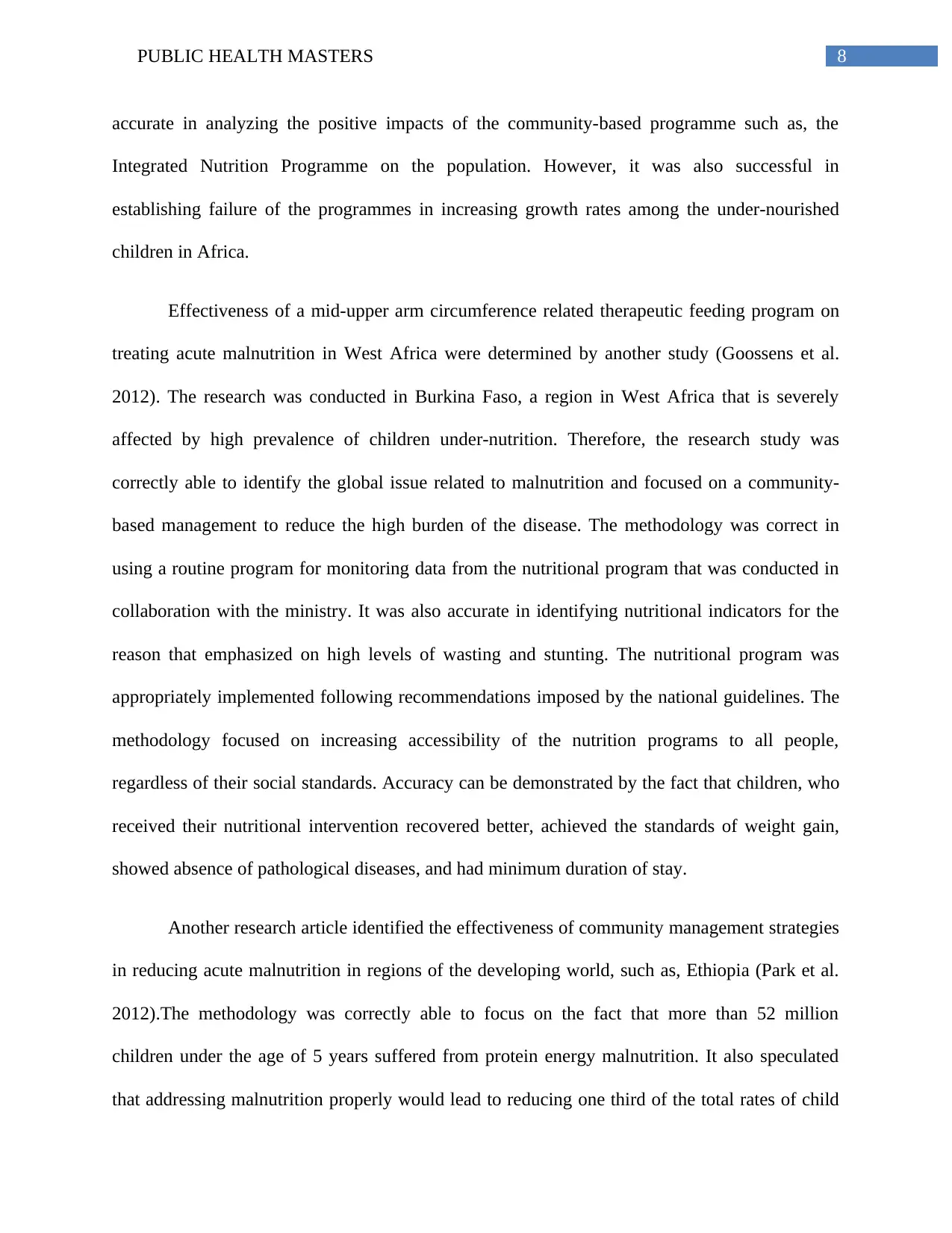
8PUBLIC HEALTH MASTERS
accurate in analyzing the positive impacts of the community-based programme such as, the
Integrated Nutrition Programme on the population. However, it was also successful in
establishing failure of the programmes in increasing growth rates among the under-nourished
children in Africa.
Effectiveness of a mid-upper arm circumference related therapeutic feeding program on
treating acute malnutrition in West Africa were determined by another study (Goossens et al.
2012). The research was conducted in Burkina Faso, a region in West Africa that is severely
affected by high prevalence of children under-nutrition. Therefore, the research study was
correctly able to identify the global issue related to malnutrition and focused on a community-
based management to reduce the high burden of the disease. The methodology was correct in
using a routine program for monitoring data from the nutritional program that was conducted in
collaboration with the ministry. It was also accurate in identifying nutritional indicators for the
reason that emphasized on high levels of wasting and stunting. The nutritional program was
appropriately implemented following recommendations imposed by the national guidelines. The
methodology focused on increasing accessibility of the nutrition programs to all people,
regardless of their social standards. Accuracy can be demonstrated by the fact that children, who
received their nutritional intervention recovered better, achieved the standards of weight gain,
showed absence of pathological diseases, and had minimum duration of stay.
Another research article identified the effectiveness of community management strategies
in reducing acute malnutrition in regions of the developing world, such as, Ethiopia (Park et al.
2012).The methodology was correctly able to focus on the fact that more than 52 million
children under the age of 5 years suffered from protein energy malnutrition. It also speculated
that addressing malnutrition properly would lead to reducing one third of the total rates of child
accurate in analyzing the positive impacts of the community-based programme such as, the
Integrated Nutrition Programme on the population. However, it was also successful in
establishing failure of the programmes in increasing growth rates among the under-nourished
children in Africa.
Effectiveness of a mid-upper arm circumference related therapeutic feeding program on
treating acute malnutrition in West Africa were determined by another study (Goossens et al.
2012). The research was conducted in Burkina Faso, a region in West Africa that is severely
affected by high prevalence of children under-nutrition. Therefore, the research study was
correctly able to identify the global issue related to malnutrition and focused on a community-
based management to reduce the high burden of the disease. The methodology was correct in
using a routine program for monitoring data from the nutritional program that was conducted in
collaboration with the ministry. It was also accurate in identifying nutritional indicators for the
reason that emphasized on high levels of wasting and stunting. The nutritional program was
appropriately implemented following recommendations imposed by the national guidelines. The
methodology focused on increasing accessibility of the nutrition programs to all people,
regardless of their social standards. Accuracy can be demonstrated by the fact that children, who
received their nutritional intervention recovered better, achieved the standards of weight gain,
showed absence of pathological diseases, and had minimum duration of stay.
Another research article identified the effectiveness of community management strategies
in reducing acute malnutrition in regions of the developing world, such as, Ethiopia (Park et al.
2012).The methodology was correctly able to focus on the fact that more than 52 million
children under the age of 5 years suffered from protein energy malnutrition. It also speculated
that addressing malnutrition properly would lead to reducing one third of the total rates of child
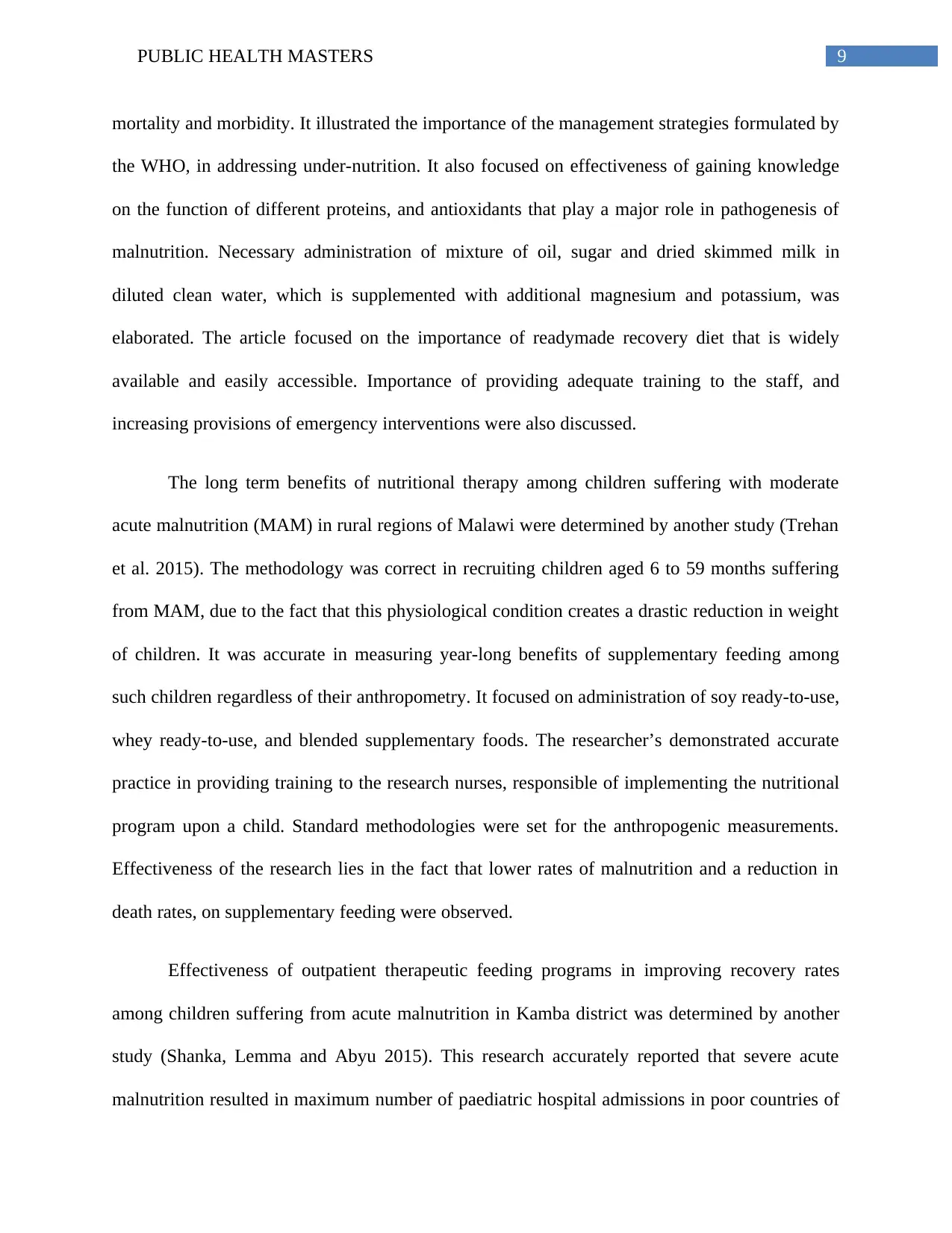
9PUBLIC HEALTH MASTERS
mortality and morbidity. It illustrated the importance of the management strategies formulated by
the WHO, in addressing under-nutrition. It also focused on effectiveness of gaining knowledge
on the function of different proteins, and antioxidants that play a major role in pathogenesis of
malnutrition. Necessary administration of mixture of oil, sugar and dried skimmed milk in
diluted clean water, which is supplemented with additional magnesium and potassium, was
elaborated. The article focused on the importance of readymade recovery diet that is widely
available and easily accessible. Importance of providing adequate training to the staff, and
increasing provisions of emergency interventions were also discussed.
The long term benefits of nutritional therapy among children suffering with moderate
acute malnutrition (MAM) in rural regions of Malawi were determined by another study (Trehan
et al. 2015). The methodology was correct in recruiting children aged 6 to 59 months suffering
from MAM, due to the fact that this physiological condition creates a drastic reduction in weight
of children. It was accurate in measuring year-long benefits of supplementary feeding among
such children regardless of their anthropometry. It focused on administration of soy ready-to-use,
whey ready-to-use, and blended supplementary foods. The researcher’s demonstrated accurate
practice in providing training to the research nurses, responsible of implementing the nutritional
program upon a child. Standard methodologies were set for the anthropogenic measurements.
Effectiveness of the research lies in the fact that lower rates of malnutrition and a reduction in
death rates, on supplementary feeding were observed.
Effectiveness of outpatient therapeutic feeding programs in improving recovery rates
among children suffering from acute malnutrition in Kamba district was determined by another
study (Shanka, Lemma and Abyu 2015). This research accurately reported that severe acute
malnutrition resulted in maximum number of paediatric hospital admissions in poor countries of
mortality and morbidity. It illustrated the importance of the management strategies formulated by
the WHO, in addressing under-nutrition. It also focused on effectiveness of gaining knowledge
on the function of different proteins, and antioxidants that play a major role in pathogenesis of
malnutrition. Necessary administration of mixture of oil, sugar and dried skimmed milk in
diluted clean water, which is supplemented with additional magnesium and potassium, was
elaborated. The article focused on the importance of readymade recovery diet that is widely
available and easily accessible. Importance of providing adequate training to the staff, and
increasing provisions of emergency interventions were also discussed.
The long term benefits of nutritional therapy among children suffering with moderate
acute malnutrition (MAM) in rural regions of Malawi were determined by another study (Trehan
et al. 2015). The methodology was correct in recruiting children aged 6 to 59 months suffering
from MAM, due to the fact that this physiological condition creates a drastic reduction in weight
of children. It was accurate in measuring year-long benefits of supplementary feeding among
such children regardless of their anthropometry. It focused on administration of soy ready-to-use,
whey ready-to-use, and blended supplementary foods. The researcher’s demonstrated accurate
practice in providing training to the research nurses, responsible of implementing the nutritional
program upon a child. Standard methodologies were set for the anthropogenic measurements.
Effectiveness of the research lies in the fact that lower rates of malnutrition and a reduction in
death rates, on supplementary feeding were observed.
Effectiveness of outpatient therapeutic feeding programs in improving recovery rates
among children suffering from acute malnutrition in Kamba district was determined by another
study (Shanka, Lemma and Abyu 2015). This research accurately reported that severe acute
malnutrition resulted in maximum number of paediatric hospital admissions in poor countries of
Secure Best Marks with AI Grader
Need help grading? Try our AI Grader for instant feedback on your assignments.
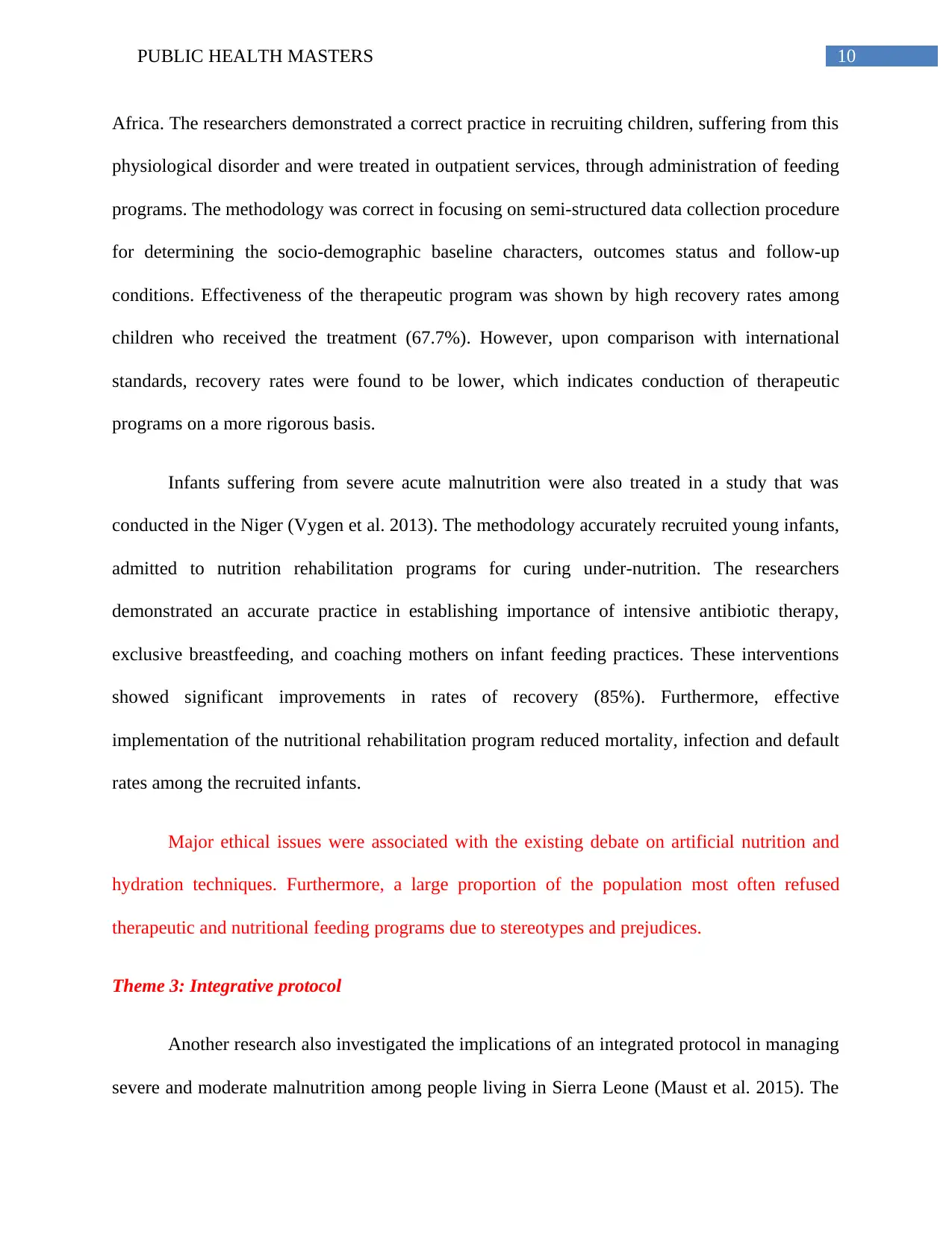
10PUBLIC HEALTH MASTERS
Africa. The researchers demonstrated a correct practice in recruiting children, suffering from this
physiological disorder and were treated in outpatient services, through administration of feeding
programs. The methodology was correct in focusing on semi-structured data collection procedure
for determining the socio-demographic baseline characters, outcomes status and follow-up
conditions. Effectiveness of the therapeutic program was shown by high recovery rates among
children who received the treatment (67.7%). However, upon comparison with international
standards, recovery rates were found to be lower, which indicates conduction of therapeutic
programs on a more rigorous basis.
Infants suffering from severe acute malnutrition were also treated in a study that was
conducted in the Niger (Vygen et al. 2013). The methodology accurately recruited young infants,
admitted to nutrition rehabilitation programs for curing under-nutrition. The researchers
demonstrated an accurate practice in establishing importance of intensive antibiotic therapy,
exclusive breastfeeding, and coaching mothers on infant feeding practices. These interventions
showed significant improvements in rates of recovery (85%). Furthermore, effective
implementation of the nutritional rehabilitation program reduced mortality, infection and default
rates among the recruited infants.
Major ethical issues were associated with the existing debate on artificial nutrition and
hydration techniques. Furthermore, a large proportion of the population most often refused
therapeutic and nutritional feeding programs due to stereotypes and prejudices.
Theme 3: Integrative protocol
Another research also investigated the implications of an integrated protocol in managing
severe and moderate malnutrition among people living in Sierra Leone (Maust et al. 2015). The
Africa. The researchers demonstrated a correct practice in recruiting children, suffering from this
physiological disorder and were treated in outpatient services, through administration of feeding
programs. The methodology was correct in focusing on semi-structured data collection procedure
for determining the socio-demographic baseline characters, outcomes status and follow-up
conditions. Effectiveness of the therapeutic program was shown by high recovery rates among
children who received the treatment (67.7%). However, upon comparison with international
standards, recovery rates were found to be lower, which indicates conduction of therapeutic
programs on a more rigorous basis.
Infants suffering from severe acute malnutrition were also treated in a study that was
conducted in the Niger (Vygen et al. 2013). The methodology accurately recruited young infants,
admitted to nutrition rehabilitation programs for curing under-nutrition. The researchers
demonstrated an accurate practice in establishing importance of intensive antibiotic therapy,
exclusive breastfeeding, and coaching mothers on infant feeding practices. These interventions
showed significant improvements in rates of recovery (85%). Furthermore, effective
implementation of the nutritional rehabilitation program reduced mortality, infection and default
rates among the recruited infants.
Major ethical issues were associated with the existing debate on artificial nutrition and
hydration techniques. Furthermore, a large proportion of the population most often refused
therapeutic and nutritional feeding programs due to stereotypes and prejudices.
Theme 3: Integrative protocol
Another research also investigated the implications of an integrated protocol in managing
severe and moderate malnutrition among people living in Sierra Leone (Maust et al. 2015). The

11PUBLIC HEALTH MASTERS
research was correct in identifying global acute malnutrition as a major problem that contributes
to high rates of mortality and morbidity among children and infants. It was also able to recognise
the fact that humanitarian emergencies like war, and draught often escalate rates of malnutrition.
Following recruitment of children with mid-upper arm circumference less than 12.5 cm, and
inadequate appetite, the researchers implemented the treatment protocol, recommended by the
government. Standard management protocol included proper administration of vaccines, food
supplements, folic acids and vitamins. They also demonstrated an accurate practice in feeding
the children with fortified blended flour that contained correct proportion of all essential
nutrients. Effectiveness of this treatment protocol can be associated with greater recovery rates,
and improved weight. The program also showed significant effects on reducing the number of
clinical visits, fever, infections and diarrhoea.
Implications of sustainable nutrition research agenda in sub-Saharan African regions
were also evaluated by a study that was correct in stating the fact that considerable economic
growth in the country fails to improve under-nutrition rates, when compared to the world (Lachat
et al. 2014). It was also correct in addressing the fact that diet related non-contagious diseases are
a major public health issue in the continent. The research focused on community interventions
for improving nutritional status among the members. It also established the importance of
behavioural strategies and food security interventions for improving impression. The findings
were accurate in stating that better governance on research that addresses nutrition problems,
aligning all nutrition related funding with priorities of the population, increasing the capacity of
nutrition research competency, and enhancing the process of information sharing in nutrition
research, are some of the major approaches that were considered essential by the primary
stakeholders of the nation.
research was correct in identifying global acute malnutrition as a major problem that contributes
to high rates of mortality and morbidity among children and infants. It was also able to recognise
the fact that humanitarian emergencies like war, and draught often escalate rates of malnutrition.
Following recruitment of children with mid-upper arm circumference less than 12.5 cm, and
inadequate appetite, the researchers implemented the treatment protocol, recommended by the
government. Standard management protocol included proper administration of vaccines, food
supplements, folic acids and vitamins. They also demonstrated an accurate practice in feeding
the children with fortified blended flour that contained correct proportion of all essential
nutrients. Effectiveness of this treatment protocol can be associated with greater recovery rates,
and improved weight. The program also showed significant effects on reducing the number of
clinical visits, fever, infections and diarrhoea.
Implications of sustainable nutrition research agenda in sub-Saharan African regions
were also evaluated by a study that was correct in stating the fact that considerable economic
growth in the country fails to improve under-nutrition rates, when compared to the world (Lachat
et al. 2014). It was also correct in addressing the fact that diet related non-contagious diseases are
a major public health issue in the continent. The research focused on community interventions
for improving nutritional status among the members. It also established the importance of
behavioural strategies and food security interventions for improving impression. The findings
were accurate in stating that better governance on research that addresses nutrition problems,
aligning all nutrition related funding with priorities of the population, increasing the capacity of
nutrition research competency, and enhancing the process of information sharing in nutrition
research, are some of the major approaches that were considered essential by the primary
stakeholders of the nation.
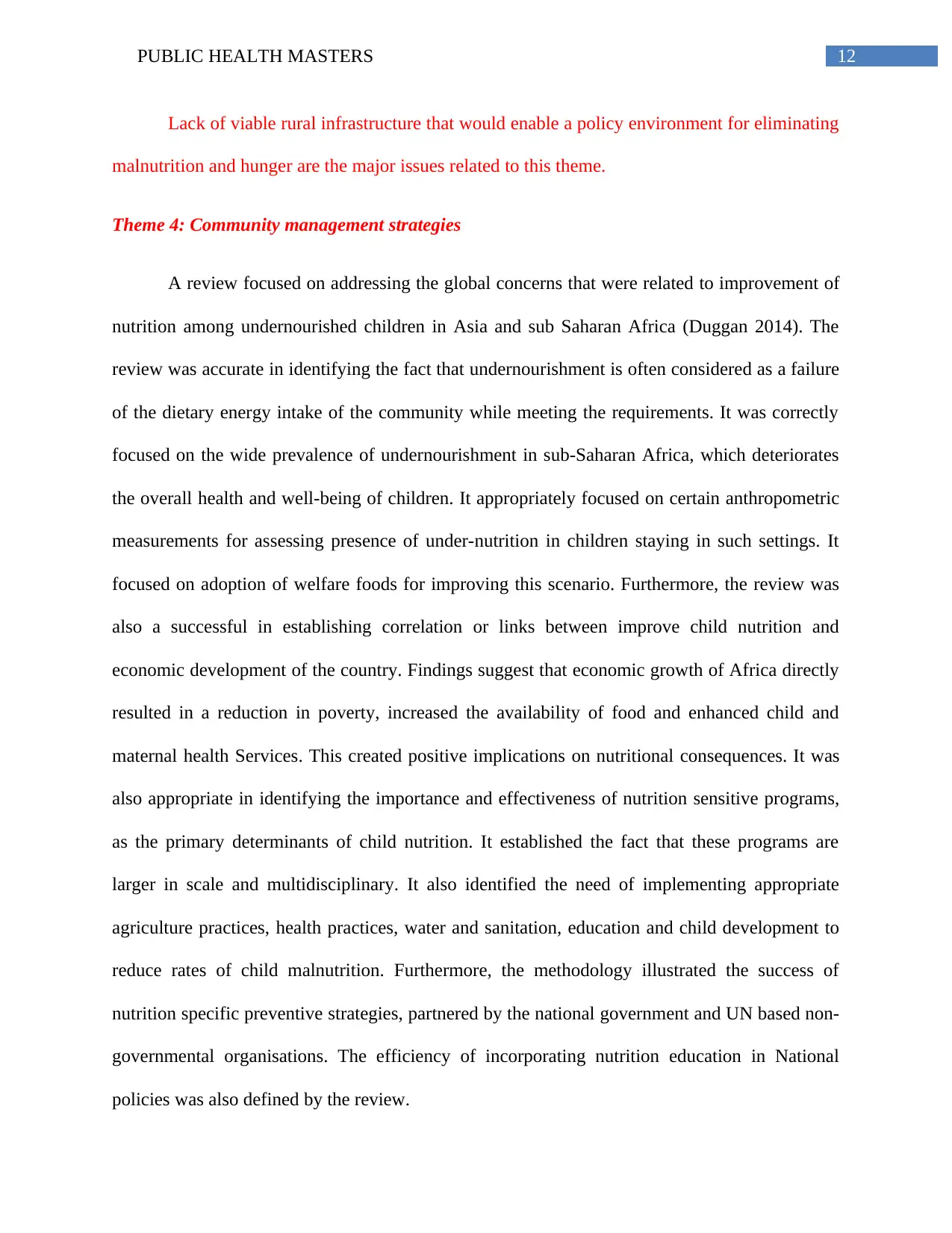
12PUBLIC HEALTH MASTERS
Lack of viable rural infrastructure that would enable a policy environment for eliminating
malnutrition and hunger are the major issues related to this theme.
Theme 4: Community management strategies
A review focused on addressing the global concerns that were related to improvement of
nutrition among undernourished children in Asia and sub Saharan Africa (Duggan 2014). The
review was accurate in identifying the fact that undernourishment is often considered as a failure
of the dietary energy intake of the community while meeting the requirements. It was correctly
focused on the wide prevalence of undernourishment in sub-Saharan Africa, which deteriorates
the overall health and well-being of children. It appropriately focused on certain anthropometric
measurements for assessing presence of under-nutrition in children staying in such settings. It
focused on adoption of welfare foods for improving this scenario. Furthermore, the review was
also a successful in establishing correlation or links between improve child nutrition and
economic development of the country. Findings suggest that economic growth of Africa directly
resulted in a reduction in poverty, increased the availability of food and enhanced child and
maternal health Services. This created positive implications on nutritional consequences. It was
also appropriate in identifying the importance and effectiveness of nutrition sensitive programs,
as the primary determinants of child nutrition. It established the fact that these programs are
larger in scale and multidisciplinary. It also identified the need of implementing appropriate
agriculture practices, health practices, water and sanitation, education and child development to
reduce rates of child malnutrition. Furthermore, the methodology illustrated the success of
nutrition specific preventive strategies, partnered by the national government and UN based non-
governmental organisations. The efficiency of incorporating nutrition education in National
policies was also defined by the review.
Lack of viable rural infrastructure that would enable a policy environment for eliminating
malnutrition and hunger are the major issues related to this theme.
Theme 4: Community management strategies
A review focused on addressing the global concerns that were related to improvement of
nutrition among undernourished children in Asia and sub Saharan Africa (Duggan 2014). The
review was accurate in identifying the fact that undernourishment is often considered as a failure
of the dietary energy intake of the community while meeting the requirements. It was correctly
focused on the wide prevalence of undernourishment in sub-Saharan Africa, which deteriorates
the overall health and well-being of children. It appropriately focused on certain anthropometric
measurements for assessing presence of under-nutrition in children staying in such settings. It
focused on adoption of welfare foods for improving this scenario. Furthermore, the review was
also a successful in establishing correlation or links between improve child nutrition and
economic development of the country. Findings suggest that economic growth of Africa directly
resulted in a reduction in poverty, increased the availability of food and enhanced child and
maternal health Services. This created positive implications on nutritional consequences. It was
also appropriate in identifying the importance and effectiveness of nutrition sensitive programs,
as the primary determinants of child nutrition. It established the fact that these programs are
larger in scale and multidisciplinary. It also identified the need of implementing appropriate
agriculture practices, health practices, water and sanitation, education and child development to
reduce rates of child malnutrition. Furthermore, the methodology illustrated the success of
nutrition specific preventive strategies, partnered by the national government and UN based non-
governmental organisations. The efficiency of incorporating nutrition education in National
policies was also defined by the review.
Paraphrase This Document
Need a fresh take? Get an instant paraphrase of this document with our AI Paraphraser
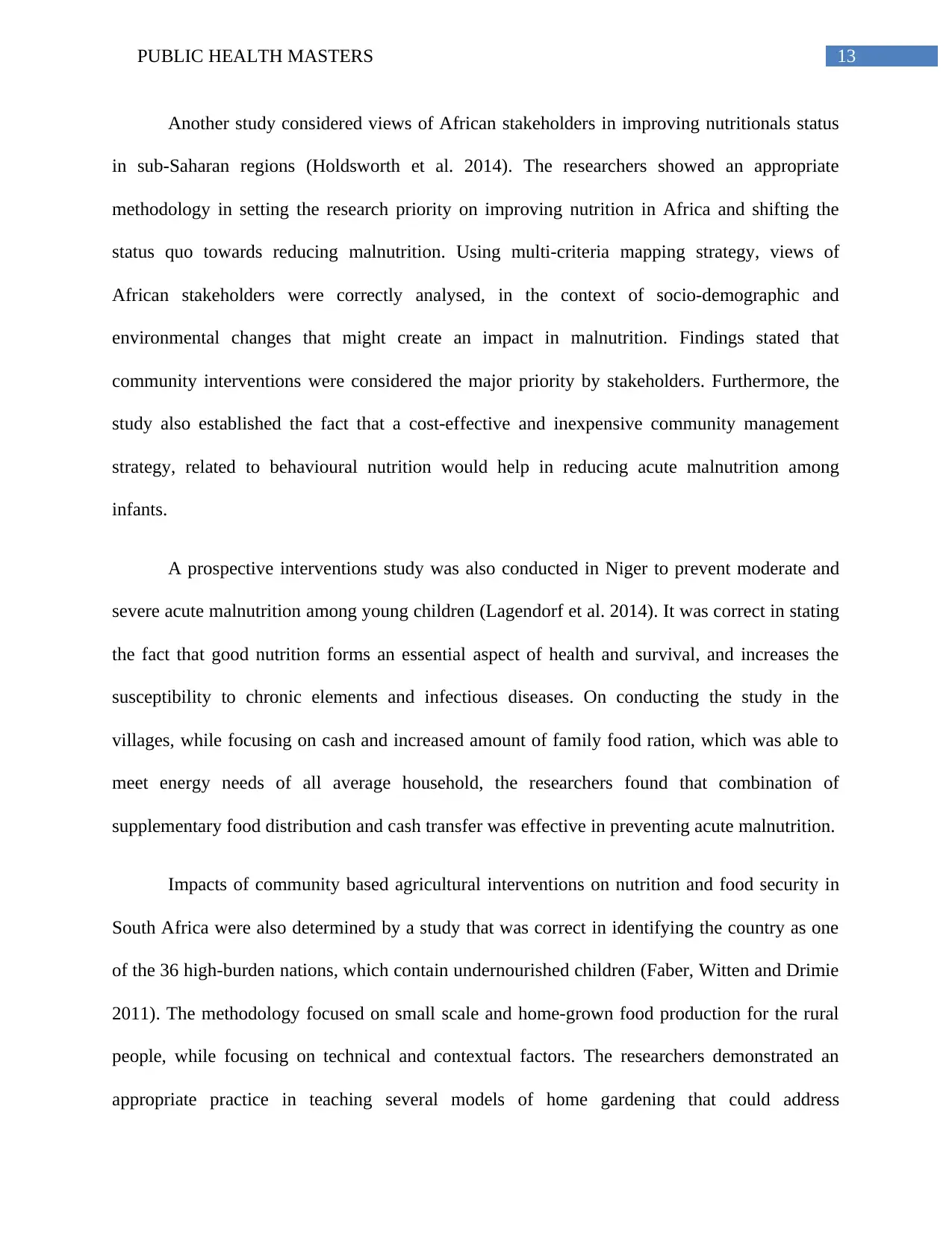
13PUBLIC HEALTH MASTERS
Another study considered views of African stakeholders in improving nutritionals status
in sub-Saharan regions (Holdsworth et al. 2014). The researchers showed an appropriate
methodology in setting the research priority on improving nutrition in Africa and shifting the
status quo towards reducing malnutrition. Using multi-criteria mapping strategy, views of
African stakeholders were correctly analysed, in the context of socio-demographic and
environmental changes that might create an impact in malnutrition. Findings stated that
community interventions were considered the major priority by stakeholders. Furthermore, the
study also established the fact that a cost-effective and inexpensive community management
strategy, related to behavioural nutrition would help in reducing acute malnutrition among
infants.
A prospective interventions study was also conducted in Niger to prevent moderate and
severe acute malnutrition among young children (Lagendorf et al. 2014). It was correct in stating
the fact that good nutrition forms an essential aspect of health and survival, and increases the
susceptibility to chronic elements and infectious diseases. On conducting the study in the
villages, while focusing on cash and increased amount of family food ration, which was able to
meet energy needs of all average household, the researchers found that combination of
supplementary food distribution and cash transfer was effective in preventing acute malnutrition.
Impacts of community based agricultural interventions on nutrition and food security in
South Africa were also determined by a study that was correct in identifying the country as one
of the 36 high-burden nations, which contain undernourished children (Faber, Witten and Drimie
2011). The methodology focused on small scale and home-grown food production for the rural
people, while focusing on technical and contextual factors. The researchers demonstrated an
appropriate practice in teaching several models of home gardening that could address
Another study considered views of African stakeholders in improving nutritionals status
in sub-Saharan regions (Holdsworth et al. 2014). The researchers showed an appropriate
methodology in setting the research priority on improving nutrition in Africa and shifting the
status quo towards reducing malnutrition. Using multi-criteria mapping strategy, views of
African stakeholders were correctly analysed, in the context of socio-demographic and
environmental changes that might create an impact in malnutrition. Findings stated that
community interventions were considered the major priority by stakeholders. Furthermore, the
study also established the fact that a cost-effective and inexpensive community management
strategy, related to behavioural nutrition would help in reducing acute malnutrition among
infants.
A prospective interventions study was also conducted in Niger to prevent moderate and
severe acute malnutrition among young children (Lagendorf et al. 2014). It was correct in stating
the fact that good nutrition forms an essential aspect of health and survival, and increases the
susceptibility to chronic elements and infectious diseases. On conducting the study in the
villages, while focusing on cash and increased amount of family food ration, which was able to
meet energy needs of all average household, the researchers found that combination of
supplementary food distribution and cash transfer was effective in preventing acute malnutrition.
Impacts of community based agricultural interventions on nutrition and food security in
South Africa were also determined by a study that was correct in identifying the country as one
of the 36 high-burden nations, which contain undernourished children (Faber, Witten and Drimie
2011). The methodology focused on small scale and home-grown food production for the rural
people, while focusing on technical and contextual factors. The researchers demonstrated an
appropriate practice in teaching several models of home gardening that could address
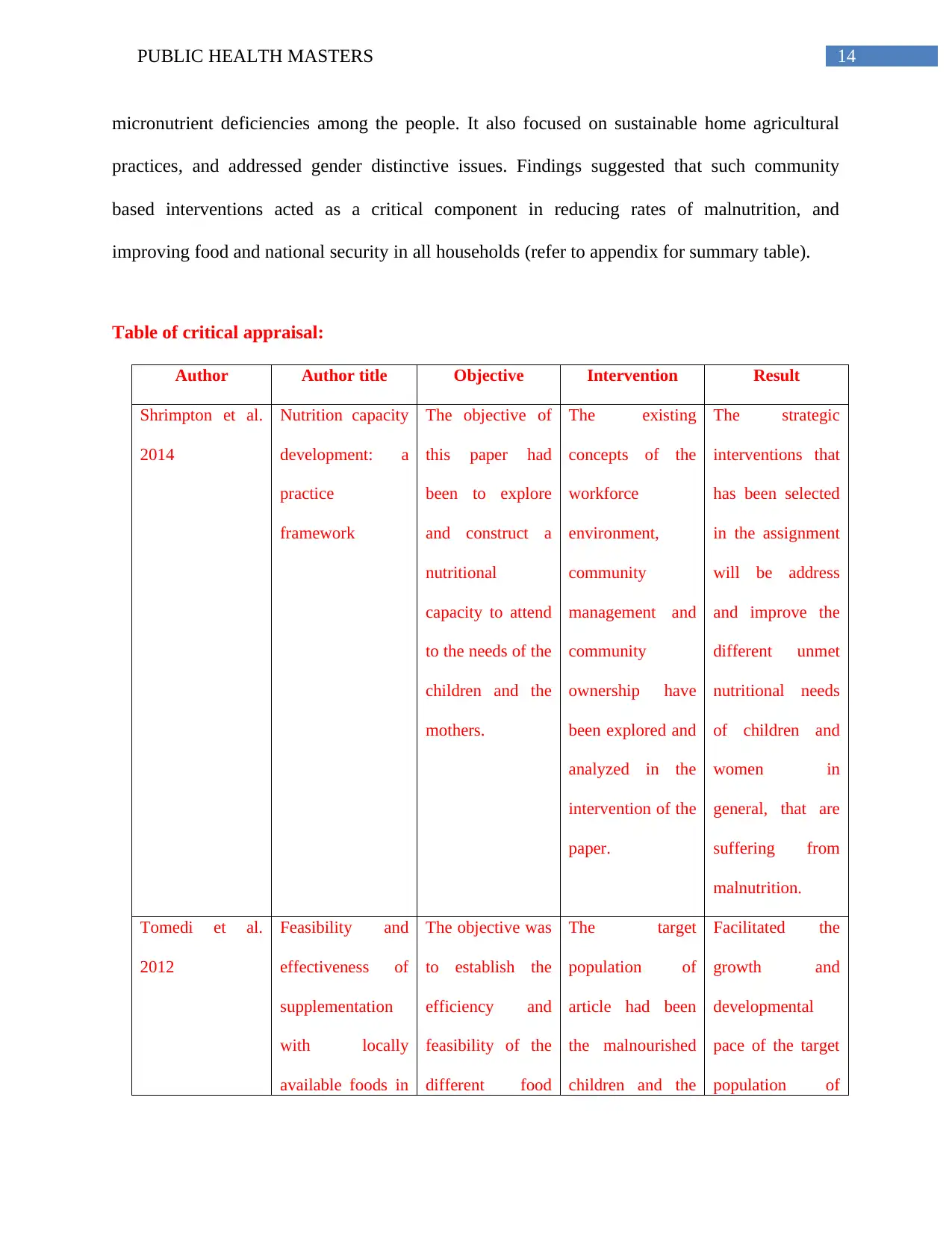
14PUBLIC HEALTH MASTERS
micronutrient deficiencies among the people. It also focused on sustainable home agricultural
practices, and addressed gender distinctive issues. Findings suggested that such community
based interventions acted as a critical component in reducing rates of malnutrition, and
improving food and national security in all households (refer to appendix for summary table).
Table of critical appraisal:
Author Author title Objective Intervention Result
Shrimpton et al.
2014
Nutrition capacity
development: a
practice
framework
The objective of
this paper had
been to explore
and construct a
nutritional
capacity to attend
to the needs of the
children and the
mothers.
The existing
concepts of the
workforce
environment,
community
management and
community
ownership have
been explored and
analyzed in the
intervention of the
paper.
The strategic
interventions that
has been selected
in the assignment
will be address
and improve the
different unmet
nutritional needs
of children and
women in
general, that are
suffering from
malnutrition.
Tomedi et al.
2012
Feasibility and
effectiveness of
supplementation
with locally
available foods in
The objective was
to establish the
efficiency and
feasibility of the
different food
The target
population of
article had been
the malnourished
children and the
Facilitated the
growth and
developmental
pace of the target
population of
micronutrient deficiencies among the people. It also focused on sustainable home agricultural
practices, and addressed gender distinctive issues. Findings suggested that such community
based interventions acted as a critical component in reducing rates of malnutrition, and
improving food and national security in all households (refer to appendix for summary table).
Table of critical appraisal:
Author Author title Objective Intervention Result
Shrimpton et al.
2014
Nutrition capacity
development: a
practice
framework
The objective of
this paper had
been to explore
and construct a
nutritional
capacity to attend
to the needs of the
children and the
mothers.
The existing
concepts of the
workforce
environment,
community
management and
community
ownership have
been explored and
analyzed in the
intervention of the
paper.
The strategic
interventions that
has been selected
in the assignment
will be address
and improve the
different unmet
nutritional needs
of children and
women in
general, that are
suffering from
malnutrition.
Tomedi et al.
2012
Feasibility and
effectiveness of
supplementation
with locally
available foods in
The objective was
to establish the
efficiency and
feasibility of the
different food
The target
population of
article had been
the malnourished
children and the
Facilitated the
growth and
developmental
pace of the target
population of
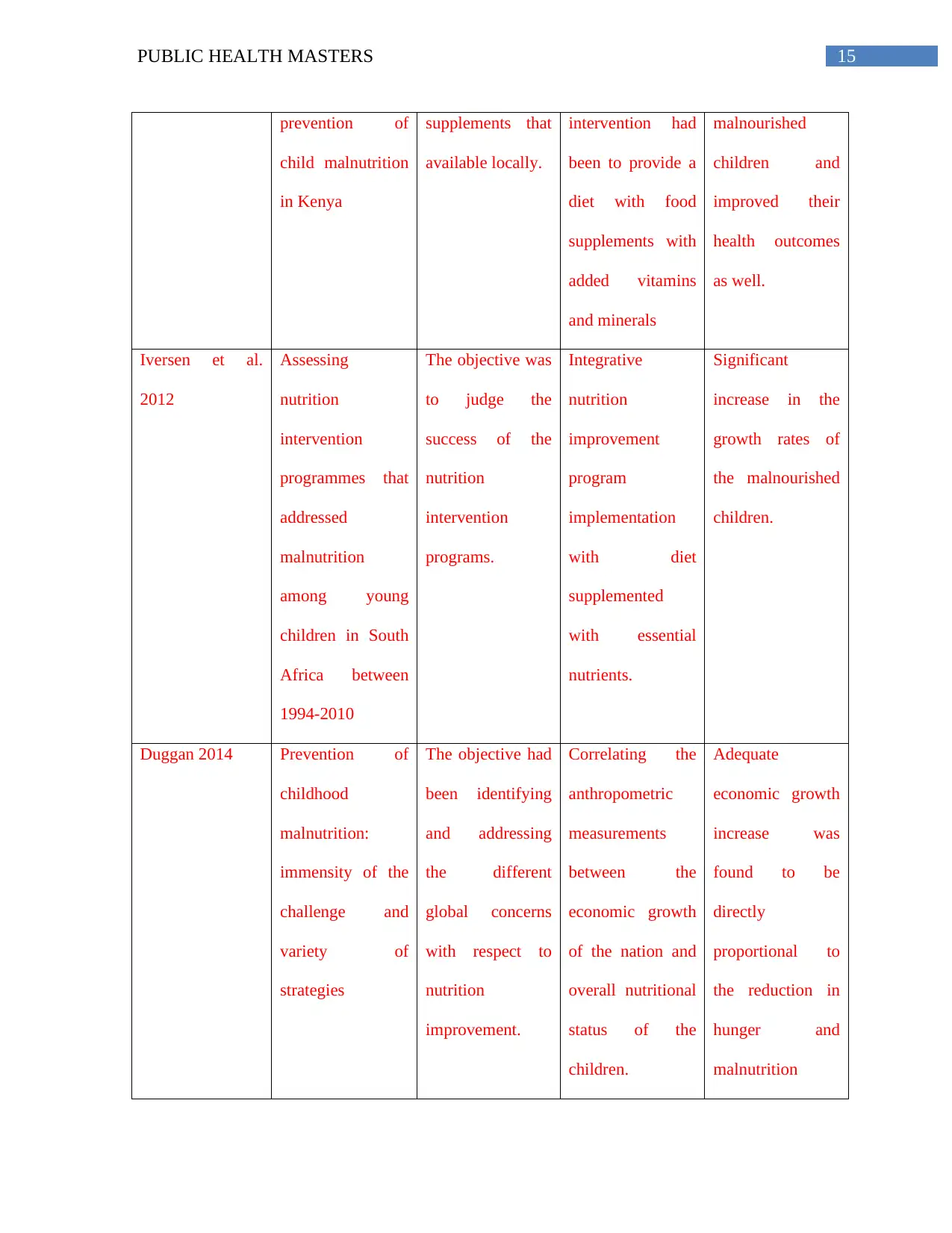
15PUBLIC HEALTH MASTERS
prevention of
child malnutrition
in Kenya
supplements that
available locally.
intervention had
been to provide a
diet with food
supplements with
added vitamins
and minerals
malnourished
children and
improved their
health outcomes
as well.
Iversen et al.
2012
Assessing
nutrition
intervention
programmes that
addressed
malnutrition
among young
children in South
Africa between
1994-2010
The objective was
to judge the
success of the
nutrition
intervention
programs.
Integrative
nutrition
improvement
program
implementation
with diet
supplemented
with essential
nutrients.
Significant
increase in the
growth rates of
the malnourished
children.
Duggan 2014 Prevention of
childhood
malnutrition:
immensity of the
challenge and
variety of
strategies
The objective had
been identifying
and addressing
the different
global concerns
with respect to
nutrition
improvement.
Correlating the
anthropometric
measurements
between the
economic growth
of the nation and
overall nutritional
status of the
children.
Adequate
economic growth
increase was
found to be
directly
proportional to
the reduction in
hunger and
malnutrition
prevention of
child malnutrition
in Kenya
supplements that
available locally.
intervention had
been to provide a
diet with food
supplements with
added vitamins
and minerals
malnourished
children and
improved their
health outcomes
as well.
Iversen et al.
2012
Assessing
nutrition
intervention
programmes that
addressed
malnutrition
among young
children in South
Africa between
1994-2010
The objective was
to judge the
success of the
nutrition
intervention
programs.
Integrative
nutrition
improvement
program
implementation
with diet
supplemented
with essential
nutrients.
Significant
increase in the
growth rates of
the malnourished
children.
Duggan 2014 Prevention of
childhood
malnutrition:
immensity of the
challenge and
variety of
strategies
The objective had
been identifying
and addressing
the different
global concerns
with respect to
nutrition
improvement.
Correlating the
anthropometric
measurements
between the
economic growth
of the nation and
overall nutritional
status of the
children.
Adequate
economic growth
increase was
found to be
directly
proportional to
the reduction in
hunger and
malnutrition
Secure Best Marks with AI Grader
Need help grading? Try our AI Grader for instant feedback on your assignments.

16PUBLIC HEALTH MASTERS
issues.
Goossens et al.
2012
Mid-upper arm
circumference
based nutrition
programming:
evidence for a
new approach in
regions with high
burden of acute
malnutrition
Judging the
efficiency of the
mid-upper arm
circumference
associated
therapeutic
feeding program
Implementation of
a community
based
management
related that
explored the
different
nutritional
indicators and the
government
recommended
feeding program
Subsequent
weight gain and
the reduction in
the rate of
pathological
disorders.
Park et al. 2012 Community
management of
acute malnutrition
in the developing
world
Judging the
efficiency of the
different strategic
interventions that
are aimed at
community
management.
Implementation of
the management
strategies
formulated by
WHO and
administration of
food mixture
supplements with
readymade diets.
Noticeable
improvements in
the overall health
status.
Trehan et al.
2015
Extending
supplementary
feeding for
children under
Exploring and
analyzing the
different benefits
of nutritional
The utilization of
blended food
items through the
supplementary
Marked reduction
in the death rates
observed and
reduction in the
issues.
Goossens et al.
2012
Mid-upper arm
circumference
based nutrition
programming:
evidence for a
new approach in
regions with high
burden of acute
malnutrition
Judging the
efficiency of the
mid-upper arm
circumference
associated
therapeutic
feeding program
Implementation of
a community
based
management
related that
explored the
different
nutritional
indicators and the
government
recommended
feeding program
Subsequent
weight gain and
the reduction in
the rate of
pathological
disorders.
Park et al. 2012 Community
management of
acute malnutrition
in the developing
world
Judging the
efficiency of the
different strategic
interventions that
are aimed at
community
management.
Implementation of
the management
strategies
formulated by
WHO and
administration of
food mixture
supplements with
readymade diets.
Noticeable
improvements in
the overall health
status.
Trehan et al.
2015
Extending
supplementary
feeding for
children under
Exploring and
analyzing the
different benefits
of nutritional
The utilization of
blended food
items through the
supplementary
Marked reduction
in the death rates
observed and
reduction in the

17PUBLIC HEALTH MASTERS
five with
moderate acute
malnutrition leads
to lower relapse
rates
therapies on the
MAM.
feeding
procedure.
rates of
malnutrition as
well.
Shanka, Lemma
and Abyu 2015
Recovery rate and
determinants in
treatment of
children with
severe acute
malnutrition using
outpatient
therapeutic
feeding program
in Kamba District,
South West
Ethiopia
Analyzing the
efficiency of the
outpatient
therapeutic
feeding programs.
Administration of
the feeding
programs on the
malnourished
children selected
for the study
followed by
which the
response on
perceived birth
outcomes were
collected.
Increase in the
recovery rates
observed.
Vygen et al. 2013 Treatment of
severe acute
malnutrition in
infants aged< 6
months in Niger
Exploration and
evaluation of
different nutrition
rehabilitation
programs in
place.
Introduction of
intensive
antibiotic
therapies
accompanied by
the different
breastfeeding and
infant feeding
Gradual reduction
in the mortality
and infection rates
observed.
five with
moderate acute
malnutrition leads
to lower relapse
rates
therapies on the
MAM.
feeding
procedure.
rates of
malnutrition as
well.
Shanka, Lemma
and Abyu 2015
Recovery rate and
determinants in
treatment of
children with
severe acute
malnutrition using
outpatient
therapeutic
feeding program
in Kamba District,
South West
Ethiopia
Analyzing the
efficiency of the
outpatient
therapeutic
feeding programs.
Administration of
the feeding
programs on the
malnourished
children selected
for the study
followed by
which the
response on
perceived birth
outcomes were
collected.
Increase in the
recovery rates
observed.
Vygen et al. 2013 Treatment of
severe acute
malnutrition in
infants aged< 6
months in Niger
Exploration and
evaluation of
different nutrition
rehabilitation
programs in
place.
Introduction of
intensive
antibiotic
therapies
accompanied by
the different
breastfeeding and
infant feeding
Gradual reduction
in the mortality
and infection rates
observed.

18PUBLIC HEALTH MASTERS
practices.
Maust et al. 2015 Severe and
Moderate Acute
Malnutrition Can
Be Successfully
Managed with an
Integrated
Protocol in Sierra
Leone–4
Evaluating the
implications of
the different
integrated
protocols
associated with
severe and acute
malnutrition.
Utilization of
strategic
combination of
both vaccination
and supplemental
feeding.
Increasing
recovery rates and
Improvement in
the weight of the
target population
observed.
Lachat et al. 2014 Developing a
sustainable
nutrition research
agenda in sub-
Saharan Africa—
findings from the
SUNRAY project
Evaluation of the
impact of the
sustainable
nutrition research
agenda
The amalgamation
of three strategic
interventions,
Community
interventions,
food security
interventions, and
behavioral
strategies
Increase in the
nutrition capacity
observed in the
target community.
Holdsworth et al.
2014
African
stakeholders’
views of research
options to
improve
nutritional status
in sub-Saharan
Africa
The goal of the
project had been
to determine the
different point of
views and the
ideologies of the
African
stakeholders to
The
implementation of
multi-criteria
mapping strategy.
The community
interventions had
been discovered
as the major
priority in the
article.
practices.
Maust et al. 2015 Severe and
Moderate Acute
Malnutrition Can
Be Successfully
Managed with an
Integrated
Protocol in Sierra
Leone–4
Evaluating the
implications of
the different
integrated
protocols
associated with
severe and acute
malnutrition.
Utilization of
strategic
combination of
both vaccination
and supplemental
feeding.
Increasing
recovery rates and
Improvement in
the weight of the
target population
observed.
Lachat et al. 2014 Developing a
sustainable
nutrition research
agenda in sub-
Saharan Africa—
findings from the
SUNRAY project
Evaluation of the
impact of the
sustainable
nutrition research
agenda
The amalgamation
of three strategic
interventions,
Community
interventions,
food security
interventions, and
behavioral
strategies
Increase in the
nutrition capacity
observed in the
target community.
Holdsworth et al.
2014
African
stakeholders’
views of research
options to
improve
nutritional status
in sub-Saharan
Africa
The goal of the
project had been
to determine the
different point of
views and the
ideologies of the
African
stakeholders to
The
implementation of
multi-criteria
mapping strategy.
The community
interventions had
been discovered
as the major
priority in the
article.
Paraphrase This Document
Need a fresh take? Get an instant paraphrase of this document with our AI Paraphraser
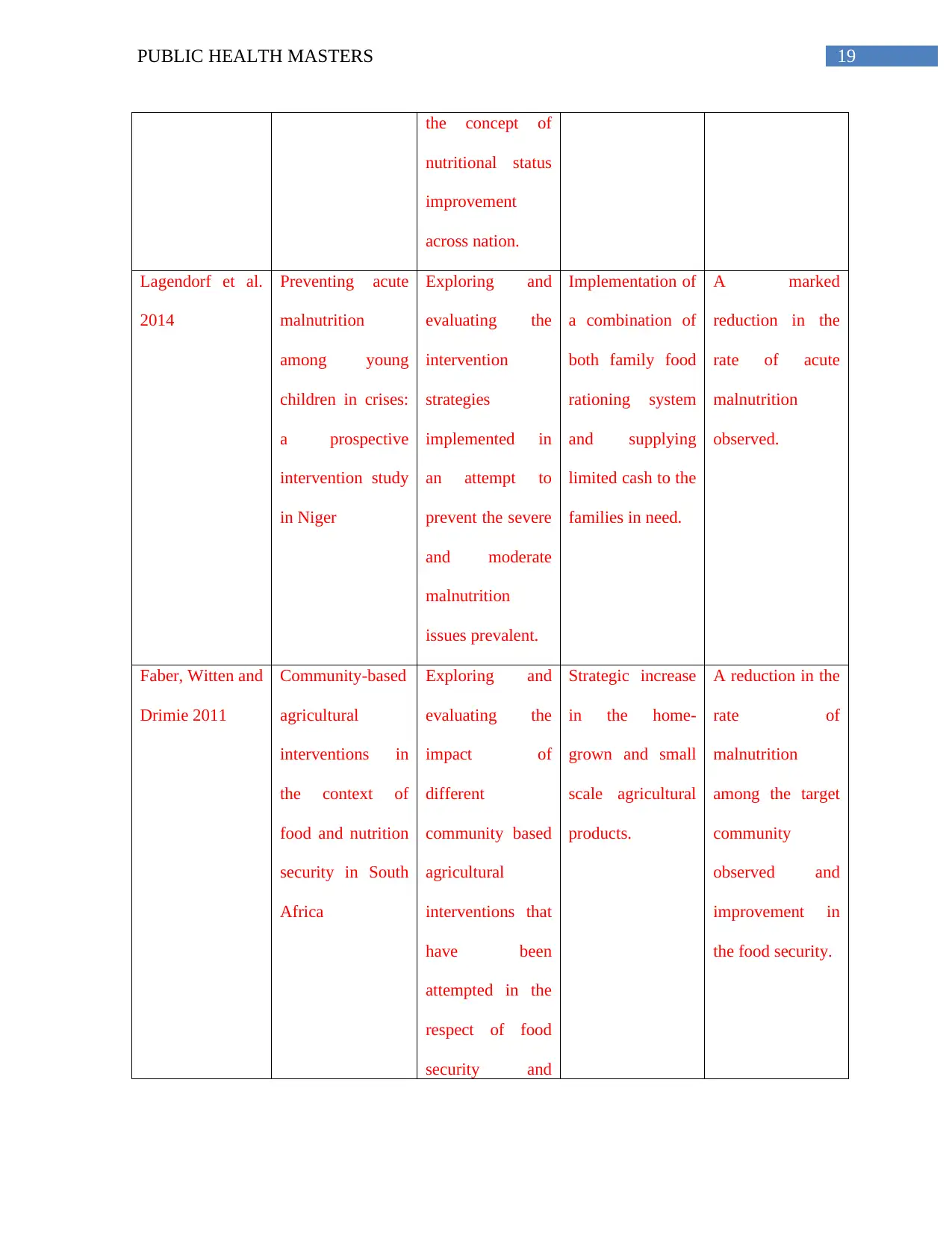
19PUBLIC HEALTH MASTERS
the concept of
nutritional status
improvement
across nation.
Lagendorf et al.
2014
Preventing acute
malnutrition
among young
children in crises:
a prospective
intervention study
in Niger
Exploring and
evaluating the
intervention
strategies
implemented in
an attempt to
prevent the severe
and moderate
malnutrition
issues prevalent.
Implementation of
a combination of
both family food
rationing system
and supplying
limited cash to the
families in need.
A marked
reduction in the
rate of acute
malnutrition
observed.
Faber, Witten and
Drimie 2011
Community-based
agricultural
interventions in
the context of
food and nutrition
security in South
Africa
Exploring and
evaluating the
impact of
different
community based
agricultural
interventions that
have been
attempted in the
respect of food
security and
Strategic increase
in the home-
grown and small
scale agricultural
products.
A reduction in the
rate of
malnutrition
among the target
community
observed and
improvement in
the food security.
the concept of
nutritional status
improvement
across nation.
Lagendorf et al.
2014
Preventing acute
malnutrition
among young
children in crises:
a prospective
intervention study
in Niger
Exploring and
evaluating the
intervention
strategies
implemented in
an attempt to
prevent the severe
and moderate
malnutrition
issues prevalent.
Implementation of
a combination of
both family food
rationing system
and supplying
limited cash to the
families in need.
A marked
reduction in the
rate of acute
malnutrition
observed.
Faber, Witten and
Drimie 2011
Community-based
agricultural
interventions in
the context of
food and nutrition
security in South
Africa
Exploring and
evaluating the
impact of
different
community based
agricultural
interventions that
have been
attempted in the
respect of food
security and
Strategic increase
in the home-
grown and small
scale agricultural
products.
A reduction in the
rate of
malnutrition
among the target
community
observed and
improvement in
the food security.

20PUBLIC HEALTH MASTERS
nutrition.
Recommendations and Conclusion
Thus, it can be stated that supplement feeding programs are an important intervention that
can help in addressing and the nutrition. Such feeding programs focus on increasing the amount
of ration for each child. They also emphasize on use of locally produced foods such as
vegetables, beans and rice that will help in supplying essential macro and micronutrients to the
diet. Consuming adequate number of blended cereals act as a major source of vitamins and
minerals. Using dry food ration or premixed ration on a weekly basis can help in providing a
dick with nutrients that are required by children. It will also improve weight. Dietary
management of children, suffering from acute malnutrition should also focus on appropriate
breast feeding practices that are inexpensive, when compared to infant formulas. Giving
adequate milk to a child helps in reducing the energy deprivation, and deficiency of vitamins and
minerals. Furthermore, it also adds essential proteins fats and nutrients to the diet. Immune
factors present in the milk will also help in eliminating infectious diseases that occurred due to
under-nutrition. Conducting appropriate training courses in hospital and outpatient facilities to
manage severely malnourished children will also help in reducing rates of paediatric deaths.
Such training programs will improve knowledge of the health workers on nutrition assessment,
thereby filling the gap.
To conclude, it can be stated that, the community should focus on adopting effective
management strategies for reducing rates of mortality morbidity and hospital admissions due to
nutrition.
Recommendations and Conclusion
Thus, it can be stated that supplement feeding programs are an important intervention that
can help in addressing and the nutrition. Such feeding programs focus on increasing the amount
of ration for each child. They also emphasize on use of locally produced foods such as
vegetables, beans and rice that will help in supplying essential macro and micronutrients to the
diet. Consuming adequate number of blended cereals act as a major source of vitamins and
minerals. Using dry food ration or premixed ration on a weekly basis can help in providing a
dick with nutrients that are required by children. It will also improve weight. Dietary
management of children, suffering from acute malnutrition should also focus on appropriate
breast feeding practices that are inexpensive, when compared to infant formulas. Giving
adequate milk to a child helps in reducing the energy deprivation, and deficiency of vitamins and
minerals. Furthermore, it also adds essential proteins fats and nutrients to the diet. Immune
factors present in the milk will also help in eliminating infectious diseases that occurred due to
under-nutrition. Conducting appropriate training courses in hospital and outpatient facilities to
manage severely malnourished children will also help in reducing rates of paediatric deaths.
Such training programs will improve knowledge of the health workers on nutrition assessment,
thereby filling the gap.
To conclude, it can be stated that, the community should focus on adopting effective
management strategies for reducing rates of mortality morbidity and hospital admissions due to

21PUBLIC HEALTH MASTERS
under-nutrition among children. Effective implementations of these community management
practices will also help in weight gain, and overall survival of the children.
Research question
The research question was kept comprehensive and precise. It is mentioned below:
Have community management efforts and interventions been successful in reducing
malnutrition rates in the African population?
References
Ahnquist, J., Wamala, S.P. and Lindstrom, M., 2012. Social determinants of health–a question of
social or economic capital? Interaction effects of socioeconomic factors on health
outcomes. Social Science & Medicine, 74(6), pp.930-939.
Bain, L.E., Awah, P.K., Geraldine, N., Kindong, N.P., Siga, Y., Bernard, N. and Tanjeko, A.T.,
2013. Malnutrition in Sub–Saharan Africa: burden, causes and prospects. Pan African Medical
Journal, 15(1), pp.1-9.
Chan, M., Kelly, J., Batterham, M. and Tapsell, L., 2012. Malnutrition (subjective global
assessment) scores and serum albumin levels, but not body mass index values, at initiation of
dialysis are independent predictors of mortality: a 10-year clinical cohort study. Journal of Renal
Nutrition, 22(6), pp.547-557.
de Sherbinin, A., 2011. The biophysical and geographical correlates of child malnutrition in
Africa. Population, Space and Place, 17(1), pp.27-46.
under-nutrition among children. Effective implementations of these community management
practices will also help in weight gain, and overall survival of the children.
Research question
The research question was kept comprehensive and precise. It is mentioned below:
Have community management efforts and interventions been successful in reducing
malnutrition rates in the African population?
References
Ahnquist, J., Wamala, S.P. and Lindstrom, M., 2012. Social determinants of health–a question of
social or economic capital? Interaction effects of socioeconomic factors on health
outcomes. Social Science & Medicine, 74(6), pp.930-939.
Bain, L.E., Awah, P.K., Geraldine, N., Kindong, N.P., Siga, Y., Bernard, N. and Tanjeko, A.T.,
2013. Malnutrition in Sub–Saharan Africa: burden, causes and prospects. Pan African Medical
Journal, 15(1), pp.1-9.
Chan, M., Kelly, J., Batterham, M. and Tapsell, L., 2012. Malnutrition (subjective global
assessment) scores and serum albumin levels, but not body mass index values, at initiation of
dialysis are independent predictors of mortality: a 10-year clinical cohort study. Journal of Renal
Nutrition, 22(6), pp.547-557.
de Sherbinin, A., 2011. The biophysical and geographical correlates of child malnutrition in
Africa. Population, Space and Place, 17(1), pp.27-46.
Secure Best Marks with AI Grader
Need help grading? Try our AI Grader for instant feedback on your assignments.
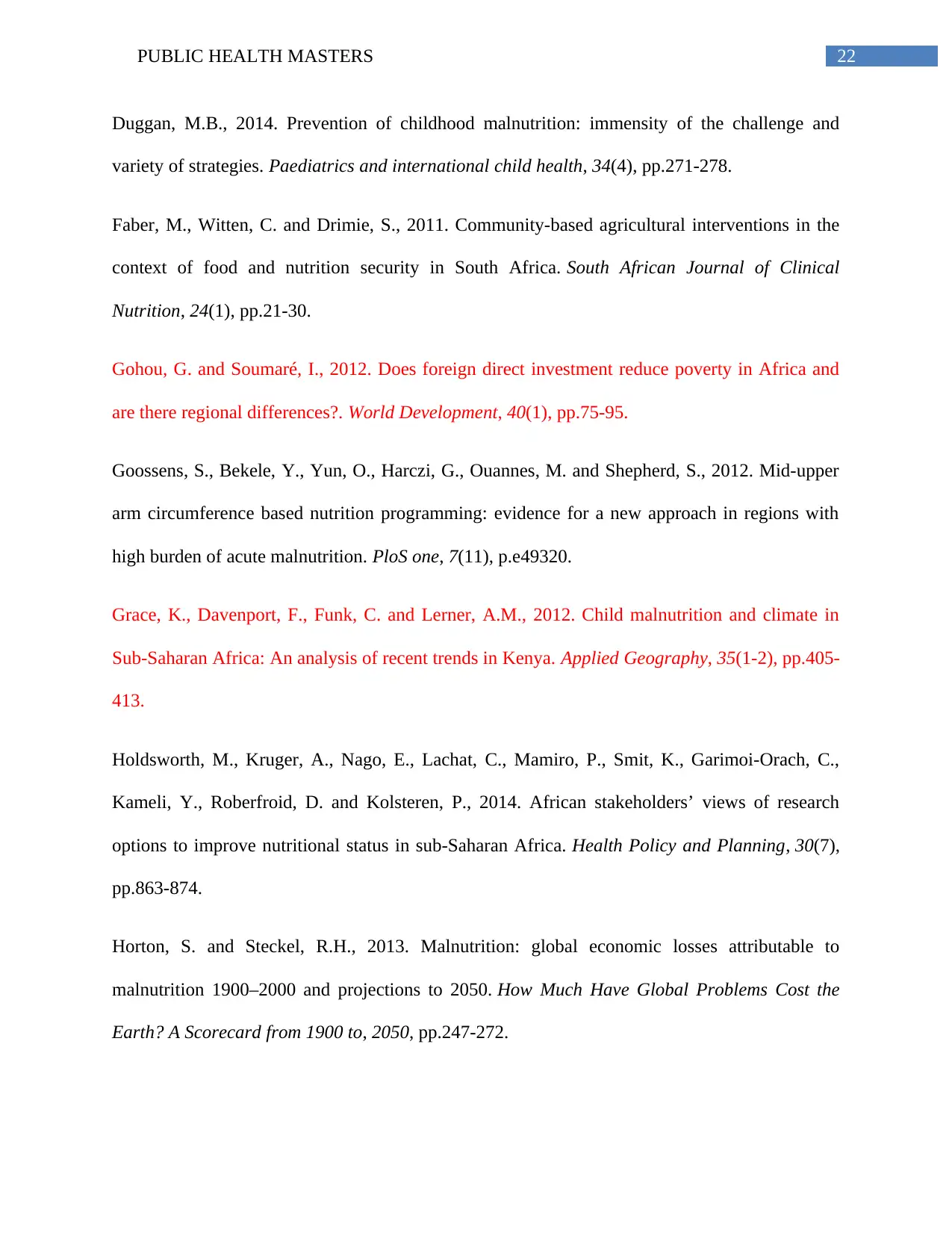
22PUBLIC HEALTH MASTERS
Duggan, M.B., 2014. Prevention of childhood malnutrition: immensity of the challenge and
variety of strategies. Paediatrics and international child health, 34(4), pp.271-278.
Faber, M., Witten, C. and Drimie, S., 2011. Community-based agricultural interventions in the
context of food and nutrition security in South Africa. South African Journal of Clinical
Nutrition, 24(1), pp.21-30.
Gohou, G. and Soumaré, I., 2012. Does foreign direct investment reduce poverty in Africa and
are there regional differences?. World Development, 40(1), pp.75-95.
Goossens, S., Bekele, Y., Yun, O., Harczi, G., Ouannes, M. and Shepherd, S., 2012. Mid-upper
arm circumference based nutrition programming: evidence for a new approach in regions with
high burden of acute malnutrition. PloS one, 7(11), p.e49320.
Grace, K., Davenport, F., Funk, C. and Lerner, A.M., 2012. Child malnutrition and climate in
Sub-Saharan Africa: An analysis of recent trends in Kenya. Applied Geography, 35(1-2), pp.405-
413.
Holdsworth, M., Kruger, A., Nago, E., Lachat, C., Mamiro, P., Smit, K., Garimoi-Orach, C.,
Kameli, Y., Roberfroid, D. and Kolsteren, P., 2014. African stakeholders’ views of research
options to improve nutritional status in sub-Saharan Africa. Health Policy and Planning, 30(7),
pp.863-874.
Horton, S. and Steckel, R.H., 2013. Malnutrition: global economic losses attributable to
malnutrition 1900–2000 and projections to 2050. How Much Have Global Problems Cost the
Earth? A Scorecard from 1900 to, 2050, pp.247-272.
Duggan, M.B., 2014. Prevention of childhood malnutrition: immensity of the challenge and
variety of strategies. Paediatrics and international child health, 34(4), pp.271-278.
Faber, M., Witten, C. and Drimie, S., 2011. Community-based agricultural interventions in the
context of food and nutrition security in South Africa. South African Journal of Clinical
Nutrition, 24(1), pp.21-30.
Gohou, G. and Soumaré, I., 2012. Does foreign direct investment reduce poverty in Africa and
are there regional differences?. World Development, 40(1), pp.75-95.
Goossens, S., Bekele, Y., Yun, O., Harczi, G., Ouannes, M. and Shepherd, S., 2012. Mid-upper
arm circumference based nutrition programming: evidence for a new approach in regions with
high burden of acute malnutrition. PloS one, 7(11), p.e49320.
Grace, K., Davenport, F., Funk, C. and Lerner, A.M., 2012. Child malnutrition and climate in
Sub-Saharan Africa: An analysis of recent trends in Kenya. Applied Geography, 35(1-2), pp.405-
413.
Holdsworth, M., Kruger, A., Nago, E., Lachat, C., Mamiro, P., Smit, K., Garimoi-Orach, C.,
Kameli, Y., Roberfroid, D. and Kolsteren, P., 2014. African stakeholders’ views of research
options to improve nutritional status in sub-Saharan Africa. Health Policy and Planning, 30(7),
pp.863-874.
Horton, S. and Steckel, R.H., 2013. Malnutrition: global economic losses attributable to
malnutrition 1900–2000 and projections to 2050. How Much Have Global Problems Cost the
Earth? A Scorecard from 1900 to, 2050, pp.247-272.
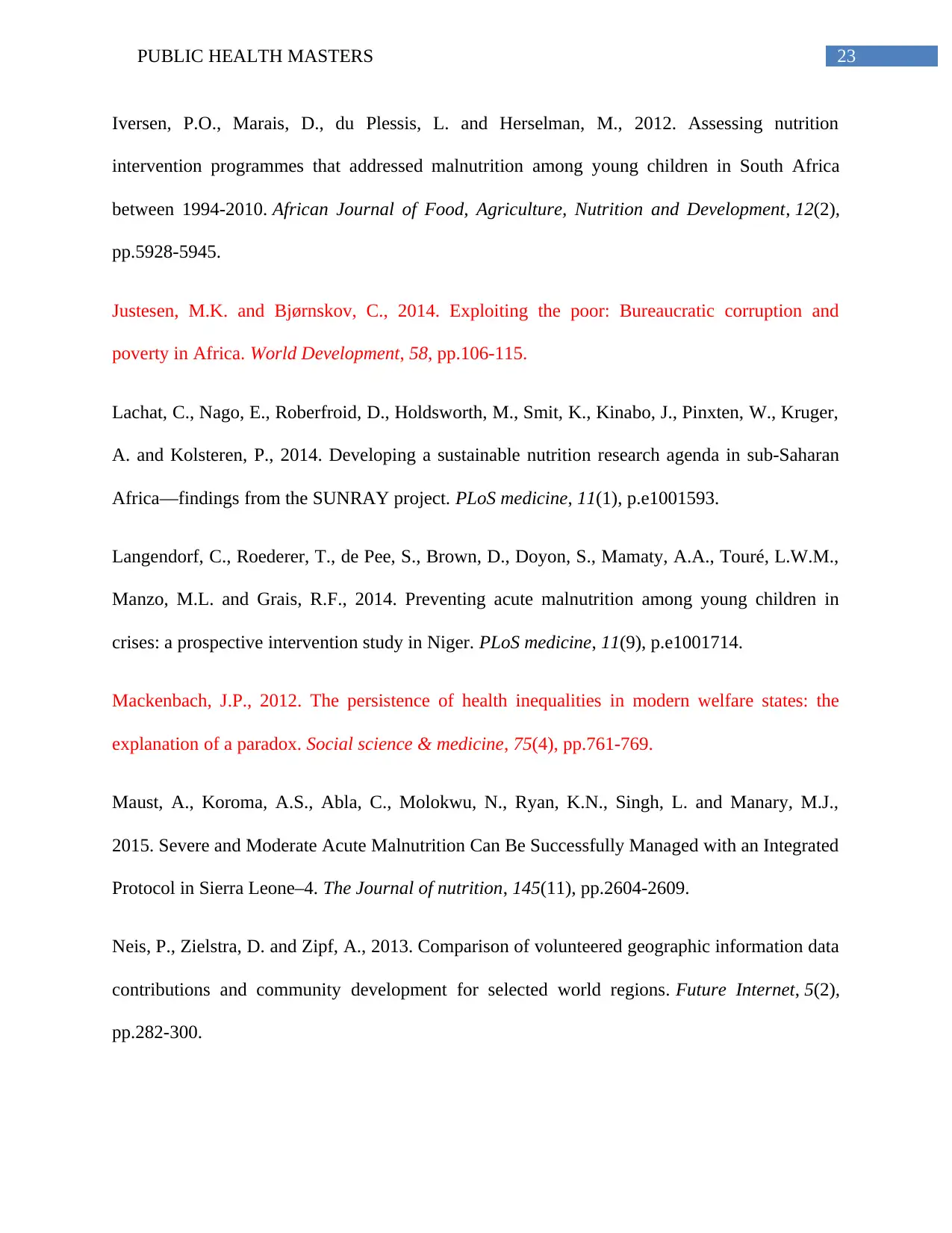
23PUBLIC HEALTH MASTERS
Iversen, P.O., Marais, D., du Plessis, L. and Herselman, M., 2012. Assessing nutrition
intervention programmes that addressed malnutrition among young children in South Africa
between 1994-2010. African Journal of Food, Agriculture, Nutrition and Development, 12(2),
pp.5928-5945.
Justesen, M.K. and Bjørnskov, C., 2014. Exploiting the poor: Bureaucratic corruption and
poverty in Africa. World Development, 58, pp.106-115.
Lachat, C., Nago, E., Roberfroid, D., Holdsworth, M., Smit, K., Kinabo, J., Pinxten, W., Kruger,
A. and Kolsteren, P., 2014. Developing a sustainable nutrition research agenda in sub-Saharan
Africa—findings from the SUNRAY project. PLoS medicine, 11(1), p.e1001593.
Langendorf, C., Roederer, T., de Pee, S., Brown, D., Doyon, S., Mamaty, A.A., Touré, L.W.M.,
Manzo, M.L. and Grais, R.F., 2014. Preventing acute malnutrition among young children in
crises: a prospective intervention study in Niger. PLoS medicine, 11(9), p.e1001714.
Mackenbach, J.P., 2012. The persistence of health inequalities in modern welfare states: the
explanation of a paradox. Social science & medicine, 75(4), pp.761-769.
Maust, A., Koroma, A.S., Abla, C., Molokwu, N., Ryan, K.N., Singh, L. and Manary, M.J.,
2015. Severe and Moderate Acute Malnutrition Can Be Successfully Managed with an Integrated
Protocol in Sierra Leone–4. The Journal of nutrition, 145(11), pp.2604-2609.
Neis, P., Zielstra, D. and Zipf, A., 2013. Comparison of volunteered geographic information data
contributions and community development for selected world regions. Future Internet, 5(2),
pp.282-300.
Iversen, P.O., Marais, D., du Plessis, L. and Herselman, M., 2012. Assessing nutrition
intervention programmes that addressed malnutrition among young children in South Africa
between 1994-2010. African Journal of Food, Agriculture, Nutrition and Development, 12(2),
pp.5928-5945.
Justesen, M.K. and Bjørnskov, C., 2014. Exploiting the poor: Bureaucratic corruption and
poverty in Africa. World Development, 58, pp.106-115.
Lachat, C., Nago, E., Roberfroid, D., Holdsworth, M., Smit, K., Kinabo, J., Pinxten, W., Kruger,
A. and Kolsteren, P., 2014. Developing a sustainable nutrition research agenda in sub-Saharan
Africa—findings from the SUNRAY project. PLoS medicine, 11(1), p.e1001593.
Langendorf, C., Roederer, T., de Pee, S., Brown, D., Doyon, S., Mamaty, A.A., Touré, L.W.M.,
Manzo, M.L. and Grais, R.F., 2014. Preventing acute malnutrition among young children in
crises: a prospective intervention study in Niger. PLoS medicine, 11(9), p.e1001714.
Mackenbach, J.P., 2012. The persistence of health inequalities in modern welfare states: the
explanation of a paradox. Social science & medicine, 75(4), pp.761-769.
Maust, A., Koroma, A.S., Abla, C., Molokwu, N., Ryan, K.N., Singh, L. and Manary, M.J.,
2015. Severe and Moderate Acute Malnutrition Can Be Successfully Managed with an Integrated
Protocol in Sierra Leone–4. The Journal of nutrition, 145(11), pp.2604-2609.
Neis, P., Zielstra, D. and Zipf, A., 2013. Comparison of volunteered geographic information data
contributions and community development for selected world regions. Future Internet, 5(2),
pp.282-300.
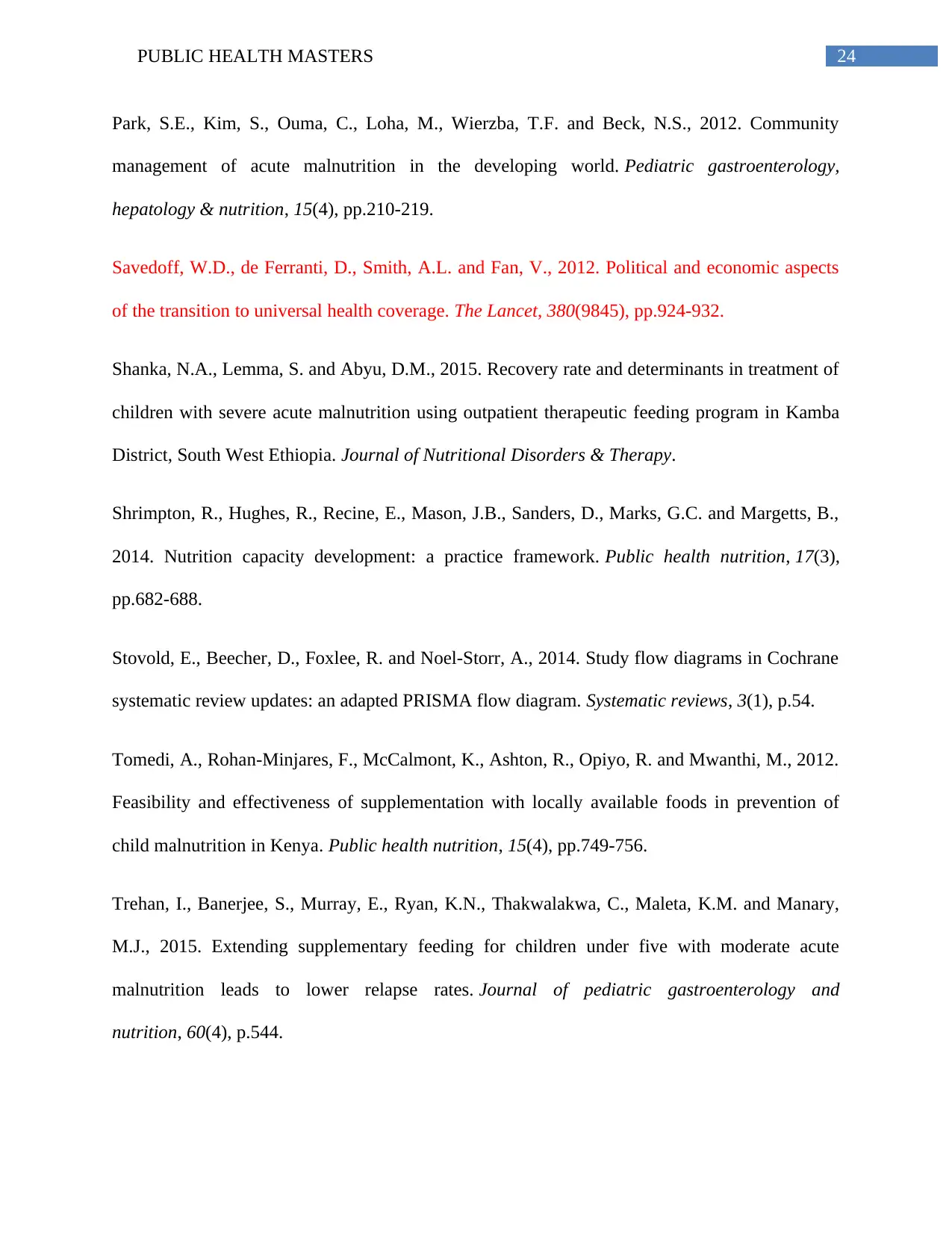
24PUBLIC HEALTH MASTERS
Park, S.E., Kim, S., Ouma, C., Loha, M., Wierzba, T.F. and Beck, N.S., 2012. Community
management of acute malnutrition in the developing world. Pediatric gastroenterology,
hepatology & nutrition, 15(4), pp.210-219.
Savedoff, W.D., de Ferranti, D., Smith, A.L. and Fan, V., 2012. Political and economic aspects
of the transition to universal health coverage. The Lancet, 380(9845), pp.924-932.
Shanka, N.A., Lemma, S. and Abyu, D.M., 2015. Recovery rate and determinants in treatment of
children with severe acute malnutrition using outpatient therapeutic feeding program in Kamba
District, South West Ethiopia. Journal of Nutritional Disorders & Therapy.
Shrimpton, R., Hughes, R., Recine, E., Mason, J.B., Sanders, D., Marks, G.C. and Margetts, B.,
2014. Nutrition capacity development: a practice framework. Public health nutrition, 17(3),
pp.682-688.
Stovold, E., Beecher, D., Foxlee, R. and Noel-Storr, A., 2014. Study flow diagrams in Cochrane
systematic review updates: an adapted PRISMA flow diagram. Systematic reviews, 3(1), p.54.
Tomedi, A., Rohan-Minjares, F., McCalmont, K., Ashton, R., Opiyo, R. and Mwanthi, M., 2012.
Feasibility and effectiveness of supplementation with locally available foods in prevention of
child malnutrition in Kenya. Public health nutrition, 15(4), pp.749-756.
Trehan, I., Banerjee, S., Murray, E., Ryan, K.N., Thakwalakwa, C., Maleta, K.M. and Manary,
M.J., 2015. Extending supplementary feeding for children under five with moderate acute
malnutrition leads to lower relapse rates. Journal of pediatric gastroenterology and
nutrition, 60(4), p.544.
Park, S.E., Kim, S., Ouma, C., Loha, M., Wierzba, T.F. and Beck, N.S., 2012. Community
management of acute malnutrition in the developing world. Pediatric gastroenterology,
hepatology & nutrition, 15(4), pp.210-219.
Savedoff, W.D., de Ferranti, D., Smith, A.L. and Fan, V., 2012. Political and economic aspects
of the transition to universal health coverage. The Lancet, 380(9845), pp.924-932.
Shanka, N.A., Lemma, S. and Abyu, D.M., 2015. Recovery rate and determinants in treatment of
children with severe acute malnutrition using outpatient therapeutic feeding program in Kamba
District, South West Ethiopia. Journal of Nutritional Disorders & Therapy.
Shrimpton, R., Hughes, R., Recine, E., Mason, J.B., Sanders, D., Marks, G.C. and Margetts, B.,
2014. Nutrition capacity development: a practice framework. Public health nutrition, 17(3),
pp.682-688.
Stovold, E., Beecher, D., Foxlee, R. and Noel-Storr, A., 2014. Study flow diagrams in Cochrane
systematic review updates: an adapted PRISMA flow diagram. Systematic reviews, 3(1), p.54.
Tomedi, A., Rohan-Minjares, F., McCalmont, K., Ashton, R., Opiyo, R. and Mwanthi, M., 2012.
Feasibility and effectiveness of supplementation with locally available foods in prevention of
child malnutrition in Kenya. Public health nutrition, 15(4), pp.749-756.
Trehan, I., Banerjee, S., Murray, E., Ryan, K.N., Thakwalakwa, C., Maleta, K.M. and Manary,
M.J., 2015. Extending supplementary feeding for children under five with moderate acute
malnutrition leads to lower relapse rates. Journal of pediatric gastroenterology and
nutrition, 60(4), p.544.
Paraphrase This Document
Need a fresh take? Get an instant paraphrase of this document with our AI Paraphraser

25PUBLIC HEALTH MASTERS
Vygen, S.B., Roberfroid, D., Captier, V. and Kolsteren, P., 2013. Treatment of severe acute
malnutrition in infants aged< 6 months in Niger. The Journal of pediatrics, 162(3), pp.515-521.
Vygen, S.B., Roberfroid, D., Captier, V. and Kolsteren, P., 2013. Treatment of severe acute
malnutrition in infants aged< 6 months in Niger. The Journal of pediatrics, 162(3), pp.515-521.
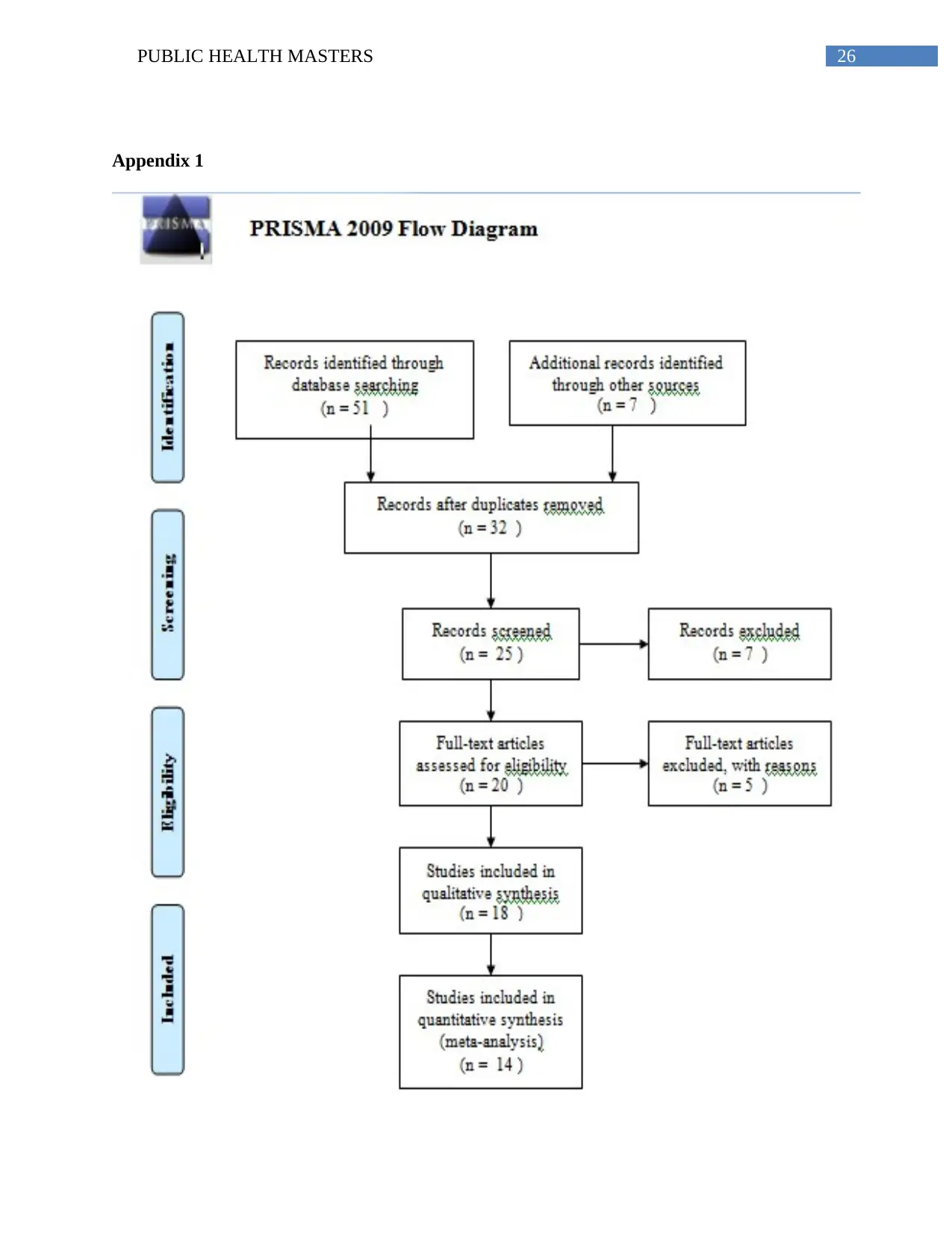
26PUBLIC HEALTH MASTERS
Appendix 1
Appendix 1
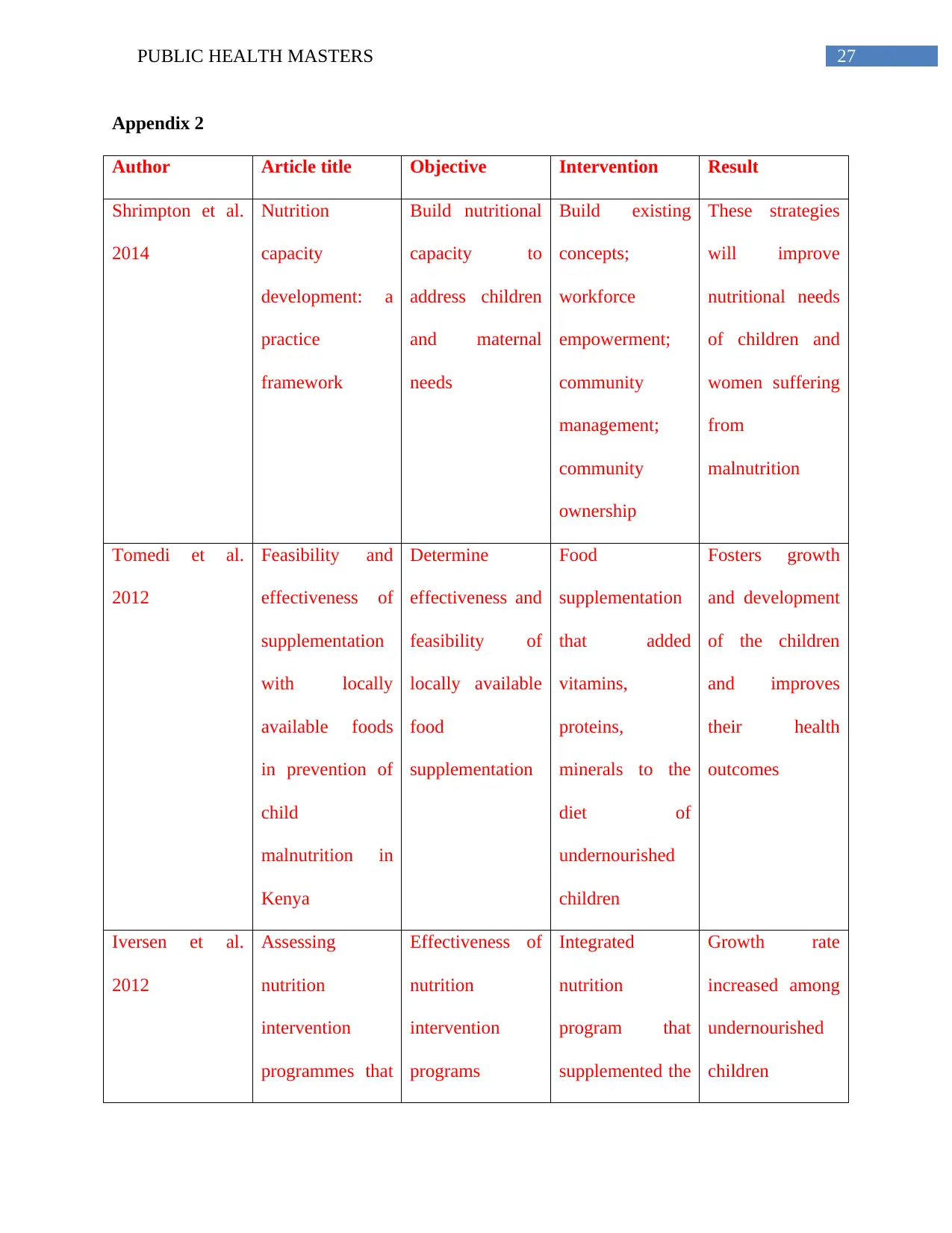
27PUBLIC HEALTH MASTERS
Appendix 2
Author Article title Objective Intervention Result
Shrimpton et al.
2014
Nutrition
capacity
development: a
practice
framework
Build nutritional
capacity to
address children
and maternal
needs
Build existing
concepts;
workforce
empowerment;
community
management;
community
ownership
These strategies
will improve
nutritional needs
of children and
women suffering
from
malnutrition
Tomedi et al.
2012
Feasibility and
effectiveness of
supplementation
with locally
available foods
in prevention of
child
malnutrition in
Kenya
Determine
effectiveness and
feasibility of
locally available
food
supplementation
Food
supplementation
that added
vitamins,
proteins,
minerals to the
diet of
undernourished
children
Fosters growth
and development
of the children
and improves
their health
outcomes
Iversen et al.
2012
Assessing
nutrition
intervention
programmes that
Effectiveness of
nutrition
intervention
programs
Integrated
nutrition
program that
supplemented the
Growth rate
increased among
undernourished
children
Appendix 2
Author Article title Objective Intervention Result
Shrimpton et al.
2014
Nutrition
capacity
development: a
practice
framework
Build nutritional
capacity to
address children
and maternal
needs
Build existing
concepts;
workforce
empowerment;
community
management;
community
ownership
These strategies
will improve
nutritional needs
of children and
women suffering
from
malnutrition
Tomedi et al.
2012
Feasibility and
effectiveness of
supplementation
with locally
available foods
in prevention of
child
malnutrition in
Kenya
Determine
effectiveness and
feasibility of
locally available
food
supplementation
Food
supplementation
that added
vitamins,
proteins,
minerals to the
diet of
undernourished
children
Fosters growth
and development
of the children
and improves
their health
outcomes
Iversen et al.
2012
Assessing
nutrition
intervention
programmes that
Effectiveness of
nutrition
intervention
programs
Integrated
nutrition
program that
supplemented the
Growth rate
increased among
undernourished
children
Secure Best Marks with AI Grader
Need help grading? Try our AI Grader for instant feedback on your assignments.
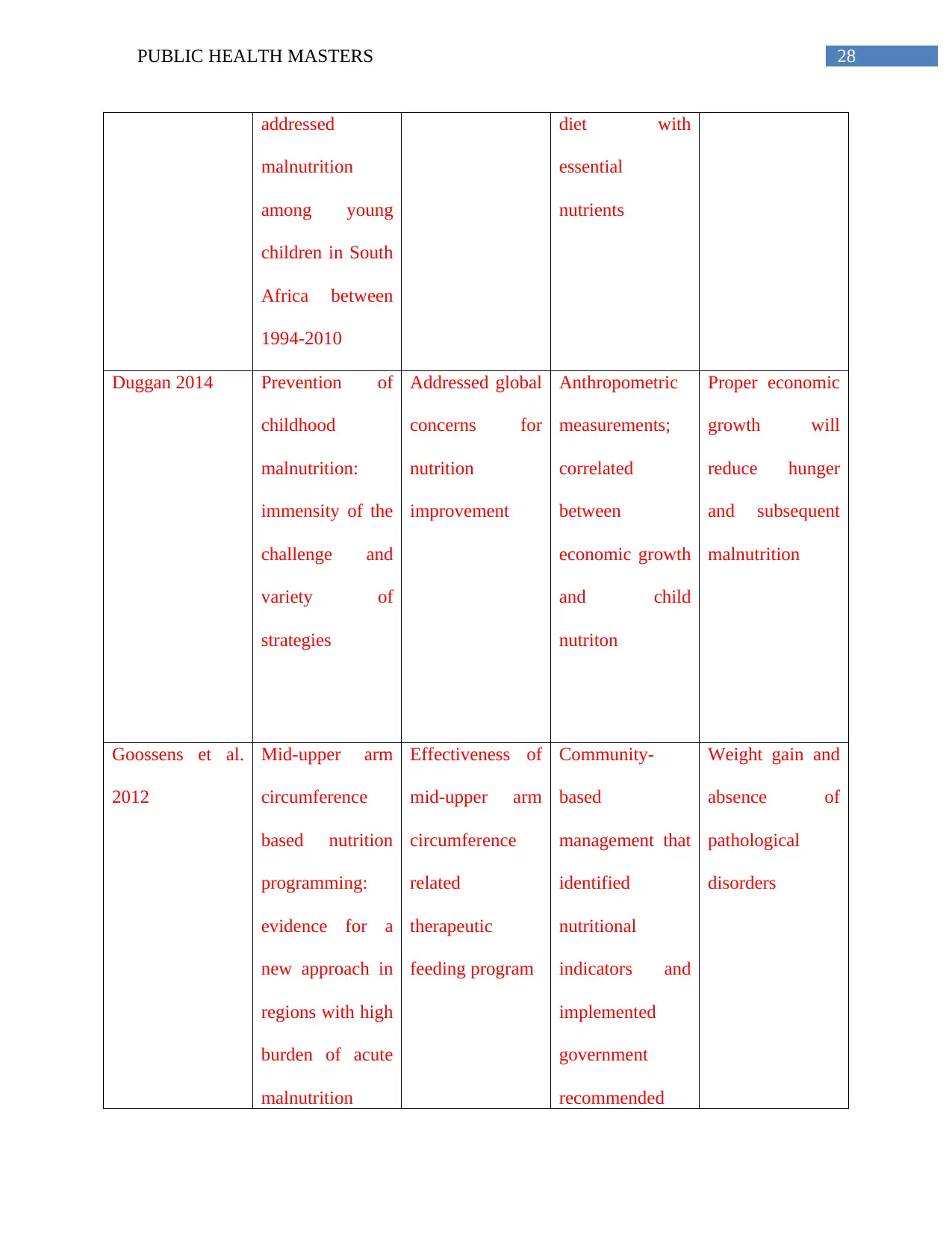
28PUBLIC HEALTH MASTERS
addressed
malnutrition
among young
children in South
Africa between
1994-2010
diet with
essential
nutrients
Duggan 2014 Prevention of
childhood
malnutrition:
immensity of the
challenge and
variety of
strategies
Addressed global
concerns for
nutrition
improvement
Anthropometric
measurements;
correlated
between
economic growth
and child
nutriton
Proper economic
growth will
reduce hunger
and subsequent
malnutrition
Goossens et al.
2012
Mid-upper arm
circumference
based nutrition
programming:
evidence for a
new approach in
regions with high
burden of acute
malnutrition
Effectiveness of
mid-upper arm
circumference
related
therapeutic
feeding program
Community-
based
management that
identified
nutritional
indicators and
implemented
government
recommended
Weight gain and
absence of
pathological
disorders
addressed
malnutrition
among young
children in South
Africa between
1994-2010
diet with
essential
nutrients
Duggan 2014 Prevention of
childhood
malnutrition:
immensity of the
challenge and
variety of
strategies
Addressed global
concerns for
nutrition
improvement
Anthropometric
measurements;
correlated
between
economic growth
and child
nutriton
Proper economic
growth will
reduce hunger
and subsequent
malnutrition
Goossens et al.
2012
Mid-upper arm
circumference
based nutrition
programming:
evidence for a
new approach in
regions with high
burden of acute
malnutrition
Effectiveness of
mid-upper arm
circumference
related
therapeutic
feeding program
Community-
based
management that
identified
nutritional
indicators and
implemented
government
recommended
Weight gain and
absence of
pathological
disorders

29PUBLIC HEALTH MASTERS
feeding program
Park et al. 2012 Community
management of
acute
malnutrition in
the developing
world
Effectiveness of
community
management
strategies
WHO formulated
management
strategies and
administration of
supplemented
food mixtures
and readymade
diets
Improvement in
health status
Trehan et al.
2015
Extending
supplementary
feeding for
children under
five with
moderate acute
malnutrition
leads to lower
relapse rates
Benefits of
nutritional
therapy on MAM
Supplementary
feeding using
blended foods
Reduced death
rates, low
malnutrition rates
Shanka, Lemma
and Abyu 2015
Recovery rate
and determinants
in treatment of
children with
severe acute
Effectiveness of
outpatient
therapeutic
feeding programs
Feeding
programs were
administered
upon children
with
Higher recovery
rates
feeding program
Park et al. 2012 Community
management of
acute
malnutrition in
the developing
world
Effectiveness of
community
management
strategies
WHO formulated
management
strategies and
administration of
supplemented
food mixtures
and readymade
diets
Improvement in
health status
Trehan et al.
2015
Extending
supplementary
feeding for
children under
five with
moderate acute
malnutrition
leads to lower
relapse rates
Benefits of
nutritional
therapy on MAM
Supplementary
feeding using
blended foods
Reduced death
rates, low
malnutrition rates
Shanka, Lemma
and Abyu 2015
Recovery rate
and determinants
in treatment of
children with
severe acute
Effectiveness of
outpatient
therapeutic
feeding programs
Feeding
programs were
administered
upon children
with
Higher recovery
rates
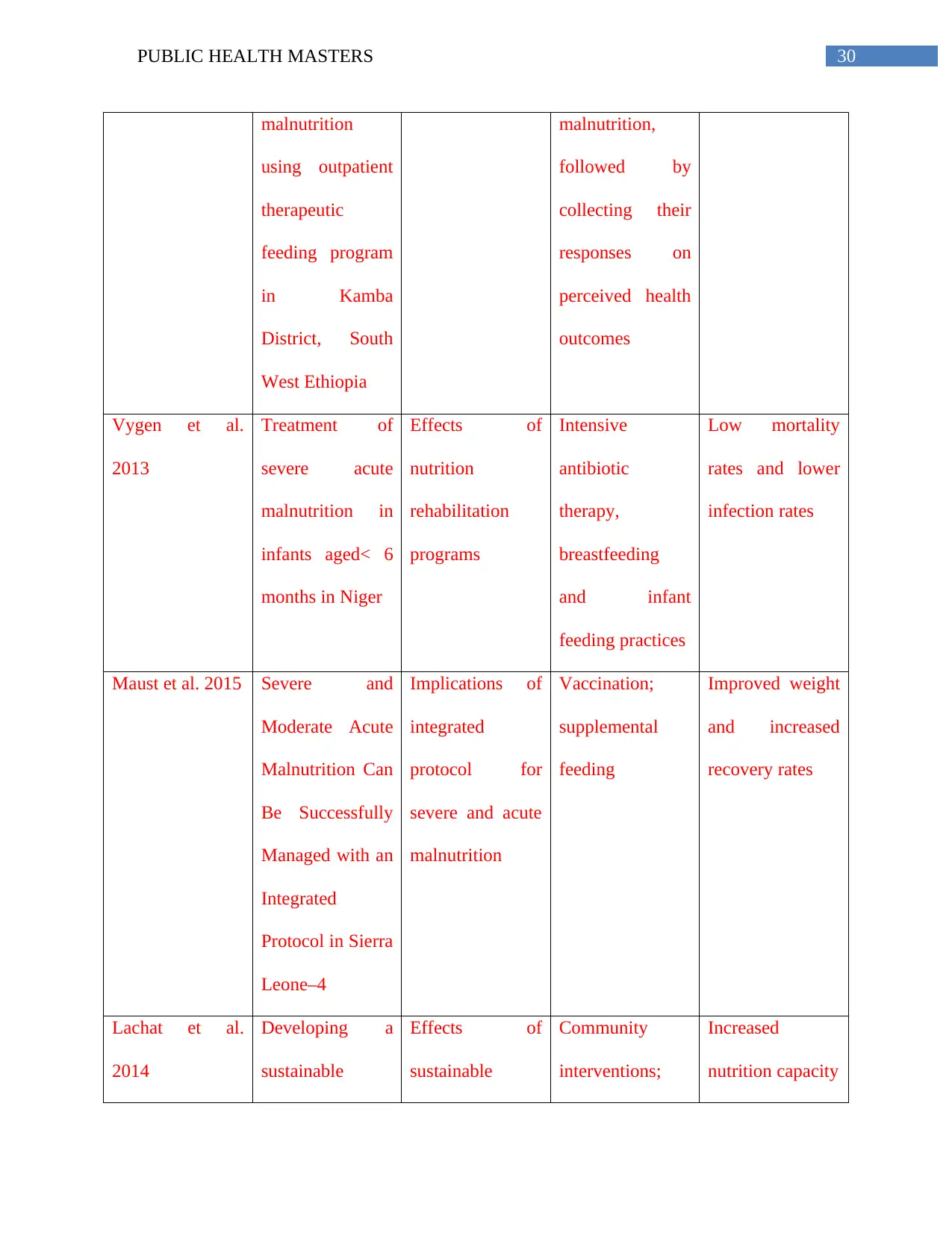
30PUBLIC HEALTH MASTERS
malnutrition
using outpatient
therapeutic
feeding program
in Kamba
District, South
West Ethiopia
malnutrition,
followed by
collecting their
responses on
perceived health
outcomes
Vygen et al.
2013
Treatment of
severe acute
malnutrition in
infants aged< 6
months in Niger
Effects of
nutrition
rehabilitation
programs
Intensive
antibiotic
therapy,
breastfeeding
and infant
feeding practices
Low mortality
rates and lower
infection rates
Maust et al. 2015 Severe and
Moderate Acute
Malnutrition Can
Be Successfully
Managed with an
Integrated
Protocol in Sierra
Leone–4
Implications of
integrated
protocol for
severe and acute
malnutrition
Vaccination;
supplemental
feeding
Improved weight
and increased
recovery rates
Lachat et al.
2014
Developing a
sustainable
Effects of
sustainable
Community
interventions;
Increased
nutrition capacity
malnutrition
using outpatient
therapeutic
feeding program
in Kamba
District, South
West Ethiopia
malnutrition,
followed by
collecting their
responses on
perceived health
outcomes
Vygen et al.
2013
Treatment of
severe acute
malnutrition in
infants aged< 6
months in Niger
Effects of
nutrition
rehabilitation
programs
Intensive
antibiotic
therapy,
breastfeeding
and infant
feeding practices
Low mortality
rates and lower
infection rates
Maust et al. 2015 Severe and
Moderate Acute
Malnutrition Can
Be Successfully
Managed with an
Integrated
Protocol in Sierra
Leone–4
Implications of
integrated
protocol for
severe and acute
malnutrition
Vaccination;
supplemental
feeding
Improved weight
and increased
recovery rates
Lachat et al.
2014
Developing a
sustainable
Effects of
sustainable
Community
interventions;
Increased
nutrition capacity
Paraphrase This Document
Need a fresh take? Get an instant paraphrase of this document with our AI Paraphraser
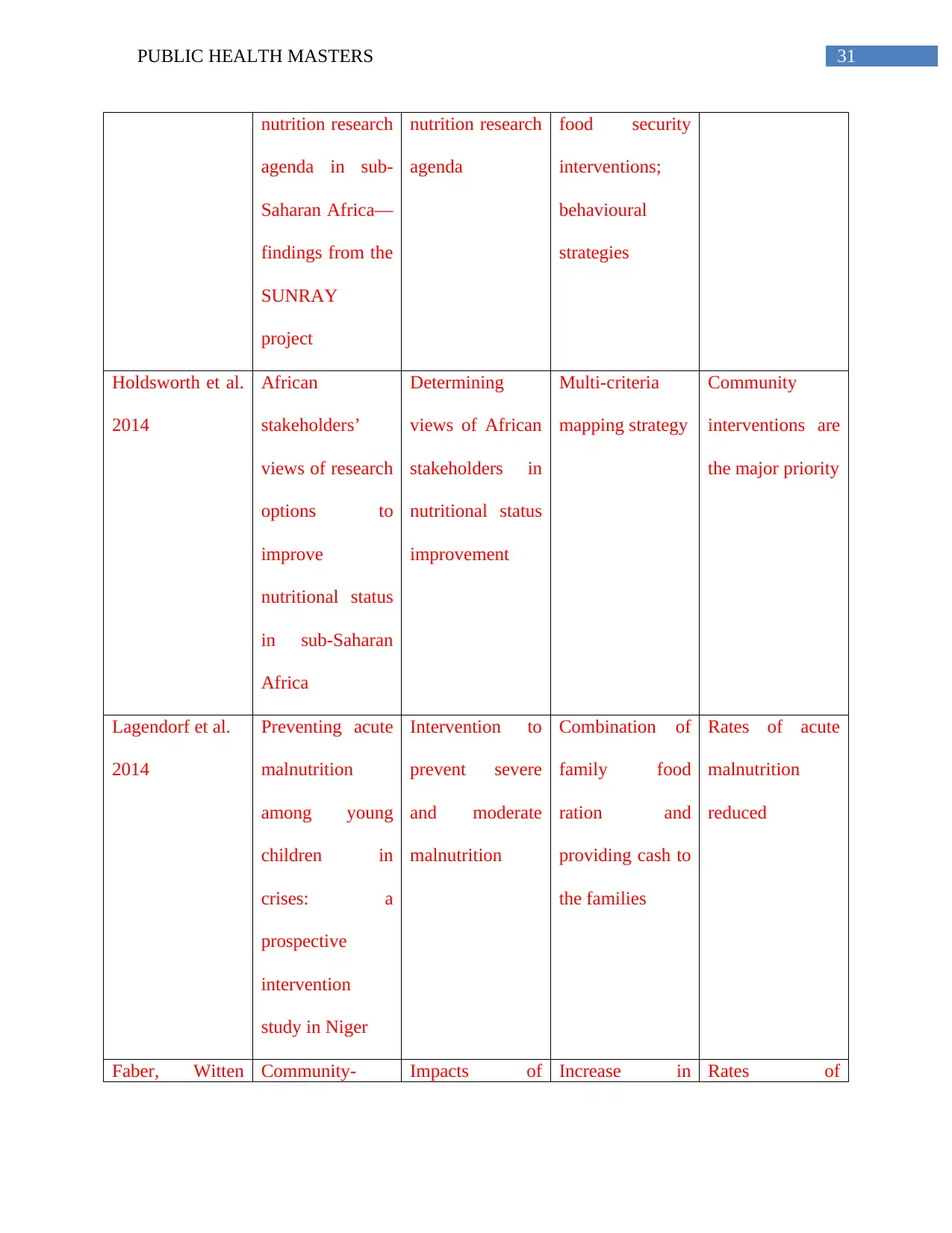
31PUBLIC HEALTH MASTERS
nutrition research
agenda in sub-
Saharan Africa—
findings from the
SUNRAY
project
nutrition research
agenda
food security
interventions;
behavioural
strategies
Holdsworth et al.
2014
African
stakeholders’
views of research
options to
improve
nutritional status
in sub-Saharan
Africa
Determining
views of African
stakeholders in
nutritional status
improvement
Multi-criteria
mapping strategy
Community
interventions are
the major priority
Lagendorf et al.
2014
Preventing acute
malnutrition
among young
children in
crises: a
prospective
intervention
study in Niger
Intervention to
prevent severe
and moderate
malnutrition
Combination of
family food
ration and
providing cash to
the families
Rates of acute
malnutrition
reduced
Faber, Witten Community- Impacts of Increase in Rates of
nutrition research
agenda in sub-
Saharan Africa—
findings from the
SUNRAY
project
nutrition research
agenda
food security
interventions;
behavioural
strategies
Holdsworth et al.
2014
African
stakeholders’
views of research
options to
improve
nutritional status
in sub-Saharan
Africa
Determining
views of African
stakeholders in
nutritional status
improvement
Multi-criteria
mapping strategy
Community
interventions are
the major priority
Lagendorf et al.
2014
Preventing acute
malnutrition
among young
children in
crises: a
prospective
intervention
study in Niger
Intervention to
prevent severe
and moderate
malnutrition
Combination of
family food
ration and
providing cash to
the families
Rates of acute
malnutrition
reduced
Faber, Witten Community- Impacts of Increase in Rates of
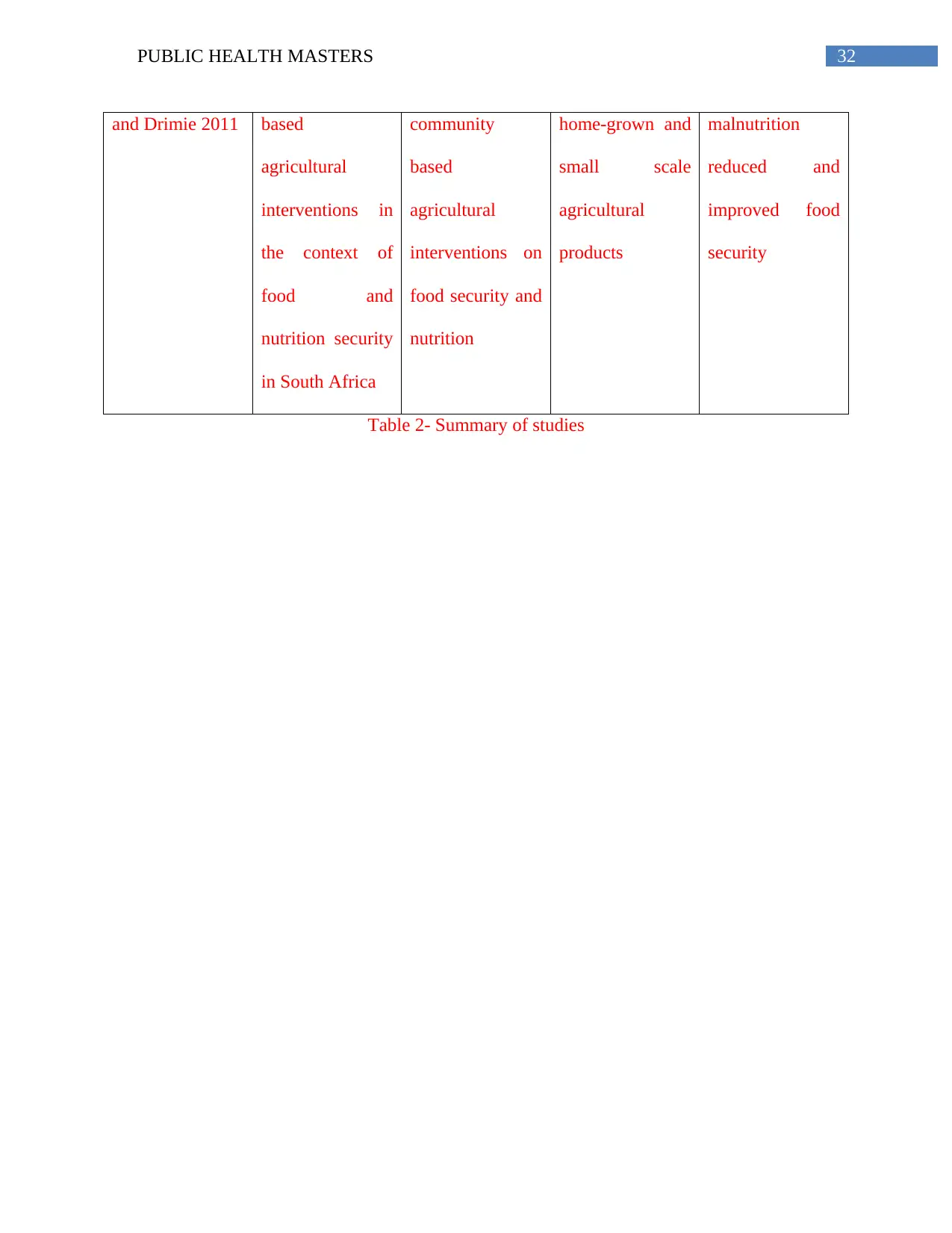
32PUBLIC HEALTH MASTERS
and Drimie 2011 based
agricultural
interventions in
the context of
food and
nutrition security
in South Africa
community
based
agricultural
interventions on
food security and
nutrition
home-grown and
small scale
agricultural
products
malnutrition
reduced and
improved food
security
Table 2- Summary of studies
and Drimie 2011 based
agricultural
interventions in
the context of
food and
nutrition security
in South Africa
community
based
agricultural
interventions on
food security and
nutrition
home-grown and
small scale
agricultural
products
malnutrition
reduced and
improved food
security
Table 2- Summary of studies
1 out of 33
Related Documents
Your All-in-One AI-Powered Toolkit for Academic Success.
+13062052269
info@desklib.com
Available 24*7 on WhatsApp / Email
![[object Object]](/_next/static/media/star-bottom.7253800d.svg)
Unlock your academic potential
© 2024 | Zucol Services PVT LTD | All rights reserved.





